Text
Final Fantasy VI: A Grand Finale
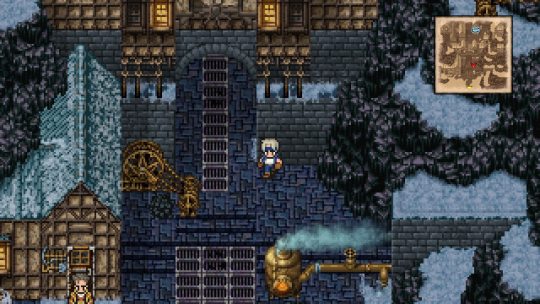
View On WordPress
#Final Fantasy Retrospectives#Final Fantasy VI#jrpgs#Pixel Remaster#role playing games#SNES#Square Enix#SquareSoft#video games#vidya thoughts
1 note
·
View note
Text
Final Fantasy V: Job System Overload

View On WordPress
#Final Fantasy#Final Fantasy Retrospectives#Final Fantasy V#jrpgs#opinion#retro gaming#rpgs#video games#vidya thoughts
0 notes
Text
RIP Akira Toriyama

It was the summer of 1996. A younger version of myself waltzed into a rip-off blockbuster, one of those family owned joints that often gets conflated with Hollywood Video, and was struck by the cover artwork of one game in particular. Chrono Trigger. It drew me in like a siren's song. It just looked so cool. I had experience with Earthbound, Super Mario RPG and Final Fantasy III at this point so I wasn't unfamiliar with the Japanese role playing game genre, but that isn't what brought me to the dance. It was the art.
Chrono Trigger would go on to become a major part of my personality as a youth. There was about a week straight where I would go around talking to nobody in particular using old English, like my favorite character Frog did. Thank you Ted Woolsey for that. CT would go on to form the basis for a lot of my video game opinions.
I remember getting Chrono Trigger for Christmas randomly in 1997. It had yet to become the holy grail of eBay, it was just a random gift from my uncle who knew how to use the Internet. I spent so long just glancing at the instruction manual and thinking the characters looked so cool. It's one thing to see a little pixel version of Lucca convince Crono that hopping into a teleporter is a good idea, it's another thing to see a fully illustrated version of the same character.
Don't even get me started on how I felt watching those anime cutscenes that came with the PS1 version for the first time. I consider Earthbound to be my favorite game ever, but Chrono Trigger is really what started my JRPG fix. Would I have gotten as deep into JRPGs as I did without Chrono Trigger? Would I be writing this right now? One of the first things I talked to my wife about was the Final Fantasy franchise, specifically my cat named Quistis. Would I have even grabbed that appreciation for Final Fantasy VIII without having been exposed to Chrono Trigger?

Fast forward to 1999. I had just moved to Colorado Springs, Colorado as a sixth grader. I had no friends. I didn't know anybody. It felt like the world had aged up around me. Everybody was using swears and talking about mature topics and I felt so out of the loop. In our temporary hotel housing I vividly remember turning the channel to Cartoon Network and stopping because the art style interested me. It looked kind of like that game I played back in 1996. Dragon Ball Z.
I can see it now. Vegeta was fighting against Recoome while Gohan and Krillin looked on exhausted. Things were looking bleak but some guy named Goku was on the horizon. I had no idea who any of these characters were but I knew they reminded me of something I loved with all my heart. From that point, Dragon Ball would go on to be something I absolutely cherished. Just like Chrono Trigger, it would help define my taste for years to come.
I remember being in high school wearing ridiculous looking Dragon Ball shirts because I thought the sleeves were really cool, I remember going to Toys R Us and seeing a damn near immobile Vegeta action figure that lacked his Saiyan-saga armor and I was so excited to bring it home. I remember hopping on limewire and downloading fansubs of Dragonball Z movies where the subtitles had characters swearing up a storm just because they could. How would I know any better? I didn't speak Japanese! I even downloaded all of Dragon Ball GT because I wanted to see where this wacky thing would go.
That specific anime would define a wide portion of my Internet life. I would post on the Funimation forums talking about whatever episode of the dub was most recent. It was there that I made a lot of my first Internet friends, including girlfriends. It was that forum that led me to create my own little Internet forum called Lindblum, a place that I still remember fondly to this day. I didn't have a lot of friends. I was an Airforce brat who moved around all the time, so it was hard for me to chat with people who knew each other for their entire lives. Lindblum was where I socialized and grew up as a person. Where I learned how to socialize and talk to people from all walks of life.
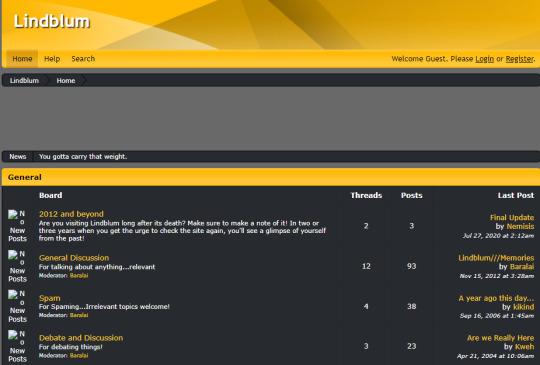
Writing on forums is what got me into writing in general. I was a lazy kid in school. I didn't care about anything except for video games. Writing was the exception to that, it was the only thing I considered myself actually decent at. I didn't understand math but I understood how to communicate what I felt to others. I work in journalism to this very day because of that fascination with writing. I have this dinky little blog I maintain because of that. Thanks to Internet forums. Thanks to Dragon Ball Z. Thanks to Chrono Trigger. Thanks to Akira Toriyama.
Toriyama, indirectly, helped shape me as an individual. A guy thousands of miles away from me who I had never met before, who didn't know my name, who didn't know I existed, had a hand in helping to shape the person I am today. The world can be a beautiful place sometimes.
RIP Akira Toriyama. Thanks for everything.

3 notes
·
View notes
Text
Final Fantasy: Mystic Quest: Another Side, Another Story
Please note, this is the latest entry in my series of Final Fantasy retrospectives that I write for a website called vidyathoughts.com. I am not able to post every single one of them on tumblr due to image restrictions, so please consider checking out the site and reading my other reviews in full. This post was edited slightly to remove some images that put me over the limit, so I apologize for the occasional long block of uninterrupted text. Thanks!
Here’s your new Final Fantasy, bro
Final Fantasy IV had come and gone and Square was very intent on making a push into North American markets. They had released SaGa games and redubbed them as spin-off Final Fantasy titles (The Final Fantasy Legend, Final Fantasy Legend II and Final Fantasy Legend III.) The first Mana title had also made the journey stateside, rechristened as Final Fantasy Adventure. The franchise seemed ready to really spread its wings with Final Fantasy V set for release in Japan in December of 1992.
Let’s revisit a quote related to the release of Final Fantasy IV in North America.
“I guess the biggest change is that they made it a little bit easier for the U.S. market, but that was because we already had Final Fantasy I, II, and III in Japan, whereas Final Fantasy I was the only one released in the states,” Final Fantasy IV lead designer Takashi Tokita said in a 2007 interview with 1up. “Final Fantasy II and III had some experimental elements to them, and so for U.S. users to suddenly dive into IV… it just seemed a little bit difficult. So we balanced it out to present it as a follow-up to Final Fantasy I. And, you know, the NES platform had a very wide range of users where the bottom end was very young, and we took that into account as well”

The difficulty issue was weighing heavily on the minds of those at SquareSoft. Final Fantasy V was the most difficult Final Fantasy title yet and the West was comprised of RPG babies at the time. They didn’t get to experience the other two Famicom titles and grow with the franchise, so they could not be expected to handle the hardcore gameplay of V. So a decision was made to release a Final Fantasy game specifically for North American audiences in order to get them more accustomed to the genre. Final Fantasy: Mystic Quest was born.
Despite being made for an American audience, development for Mystic Quest was handled by an internal Japanese SquareSoft team led by Kouzi Ide. Ide’s most notable work to this point was as the lead for the third SaGa title, which North American players would receive as Final Fantasy Legend III. Ide would only direct one more game after Mystic Quest, Treasure of Rudras, which only saw release in Japan. I would normally say that since it’s been nearly 30 years you shouldn’t count on ever getting a version of that game in North America, but they released Live-A-Live over here eventually so I guess anything is possible.
Mystic Quest is also the first game credited to Ted Woolsey, who was the lead localizer at SquareSoft during the SNES era. His translations are known to be a tad bit more colorful than your typical works of the time. This leads to a lot of his writing quirks being referred to as Woolseyisms. This ranges from his take on Frog speaking in olde English in Chrono Trigger (despite nobody else in the middle ages knowing what thees and thous are in that game) to Kefka’s infamous “Son of a Submariner” line from Final Fantasy VI. Most of his work has been retranslated over the years, but odds are if you played a SNES game made by SquareSoft, you’ve experienced his work in some way.
Woolsey at his finest, in my opinion anyway, is Super Mario RPG. I think his quirky style helped give that game a lot more of a life than it could have had. SMRPG was my very first role playing game and I credit it with getting me into the genre. It accomplished what Mystic Quest was trying to.
Here is what Woolsey said about the prospect of moving Final Fantasy V westward in an interview with Super Play Magazine in 1994:
“The Final Fantasy series basically has two separate tracks: the odd series (FFI, FFIII and FFV) are controller command drive games, whereas the even series are more story line driven games. As for FFV though, well, although we’re sure it’s a great title it hasn’t been a hit with too many people in our focus groups, although experienced gamers loved the complex character building – it’s just not accessible enough to the average gamer. But we’re determined we want to release it so we’re going to wait and introduce it once there’s a larger audience for that particular style.”
Now obviously Woolsey isn’t a major decision maker at Square. He didn’t pull aside upper management and warn them about the dangers of the Job system. But he would certainly know of what games are being localized and why certain ones are being skipped over.
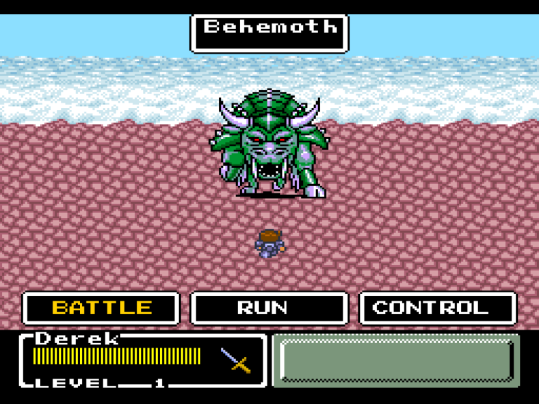
Mass appeal
From the above quote, we can guess that Final Fantasy V’s fate might have been determined by focus groups. Before I even sat down to write this retrospective, the feeling I had while playing Mystic Quest was ‘this is a focus grouped Final Fantasy.’ It’s nice to have the lead localizer sort of confirm that there might have been a little truth to that. The original plan for Final Fantasy V would have seen it released as a spin-off title of some sort, but I will get more into what they did with V later (Spoiler: not release it in America at all until the next console generation.)
Mystic Quest would release in North America just two months before the Japanese release of Final Fantasy V. It would later go on to release in Japan as Final Fantasy USA: Mystic Quest in September of 1993. Final Fantasy VI was released in April of 1994, so expectations probably weren’t too high for the spin-off title in Japan.
The first time I saw MQ was as a middle schooler. I wasn’t terribly interested in playing it, I was too hyper-fixated on the PS1 Final Fantasy games I could not play for myself at the time, and for some reason a shard stuck in my mind that correlated Final Fantasy II (IV) with it. So for a long time I knew the first four mainline Final Fantasy titles North America got as: Final Fantasy, Final Fantasy II: Mystic Quest, Final Fantasy III and Final Fantasy VII. The 90s were a different, more confusing time.
In discussing how Mystic Quest differs from your standard Final Fantasy, let’s explore the focus group idea a little bit. Allow me to pretend to give feedback to SquareSoft as a non-RPG playing fella on Final Fantasy IV and talk about how these concerns were addressed. Remember: Square wants Final Fantasy and role playing games to be a massive hit in North America. They want what Enix had with Dragon Quest where Japanese police officers beg them not to release the game during the school week. Final Fantasy definitely had a host of hardcore fans in North America, but an absolute mainstream fervor would not encompass the west until Final Fantasy VII’s release.
“Five is a lot of party members, I can’t keep track of all this stuff!”
Mystic Quest trims your party down to only two characters and if you so choose, you only need to control one character. The game defaults to your secondary character acting automatically, though you can press a button to change to manual commands. MQ also utilizes the Final Fantasy II and IV approach of having characters constantly entering and exiting your party. The secondary character is always a fair deal stronger than your main character when they show up but by the time they leave, your protagonist should be equal to or greater than them. It’s an easy way to determine whether someone is going to leave your party soon or not. Are you their level? If so, prepare to say goodbye!
I find that if you play on auto, the computer will cheat for you. At some point I switched to auto mode because I wanted to move this along. The combat system isn’t terribly deep with two people so the battle-to-battle strategic decisions didn’t matter so much. I would notice on certain turns that sometimes my main character would get hit with a big critical by an enemy and then my partner would heal me back up before it became time to input moves again. My character gets stoned – no I do not know a better way to word this – and my partner would cast heal. In manual, I would have had to plan ahead for that. I guess they try to give you every leg up that they can?
There were a couple of times later on I had to switch back to manual combat for my partner to do something specific, but it was very seldom.
As a result of having only two party members, battles don’t have a lot of strategy. Towards the end of the game, some encounters will feature minor hurdles with enemies that will reflect your magic or give you a status effect if you attack them physically, but outside of that most encounters feel the same. The only real differences come down to the sprites. You either both attack or one of you heals. There are status effects to manage but there’s no buffs or nerfs. It’s very straightforward.
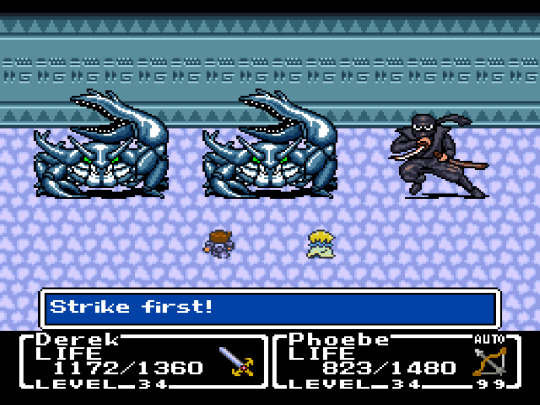
“This ATB system is so hard to figure out. I was browsing that old guy’s spells looking for meteor and some random bad guy called Red Eye swooped in and killed me while I was looking!”
True turn-based gameplay is back. So if you were getting sick of holding it in while you wait for battles to play out, you can once again tell your main character to act and then run out to the bathroom while everyone takes their turn. Given that you only have to put in your main protagonist’s commands if you’re on auto battle, this can lead to some very repetitive encounters. For a large portion of the game, I was just having my two characters attack. I know I said in my FF1-3 recaps that I spend most of my battles just physically attacking but at least there were four party members to choose from. Like if I wanted to attack enemies in other ways, I definitely had options. It felt a little more in depth.
“What’s the deal with all these status effects? How do I cure them? What’s the difference between confused and charmed?”
Status effects remain, but dealing with them is a little simpler than it was in the past. Up to this point, each status effect could be cured with a specific item. There was also the ‘cure all’ item, remedy. These are usually rare and expensive, so it encouraged the player to only use those in emergencies. Better yet, use Esuna! Forget items!
In MQ, there is only one item that heals status effects. It is pretty easily obtained and ensures that status effects will never really hamper your playtime unless you just outright ignore them for some reason. Which you can certainly do because I tackled the first major dungeon of the game poisoned for at least 3/4 of it. Your rotating secondary party member almost always has some white magic, so they’ll usually be able to heal you too. And if they can’t heal you, they’ll probably have the Life spell which will revive you. They also very generously make Life the equivalent to Full Life in Final Fantasy IV, i.e. you respawn with full health.
I will say that with two party members, encountering enemies that throw around status effects willy nilly can be slightly frustrating. There were a couple of times where both my party members were confused or asleep or something and I had to wait for the enemy AI to smack me before I could do anything. I also had a couple of unlucky battles where both of my fellas would get stoned right away, which is an instant game over. It doesn’t happen enough to be annoying but it does happen. Generally if you heal status effects as they come, it’s no big deal.
“Why are there so many spells? How do I know which one to use? Is Fire 2 better than Blizzard 2? Why does Fire need a sequel? It takes me forever to see my spells!”
Your total spell count is really low. Observe.
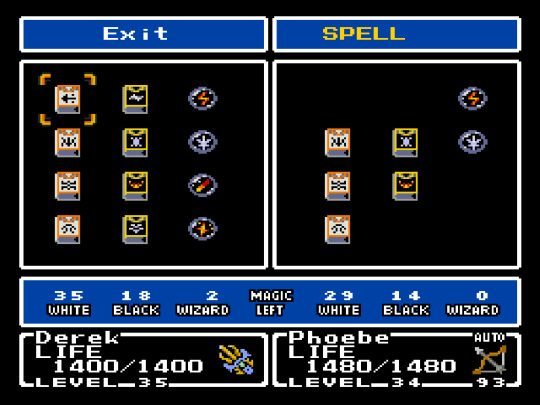
The spell book on the left is the main character’s magic and those 12 spells represent your entire catalogue. You have four white magic spells, four black magic spells and four wizard spells. For white magic you get Cure, Heal, Exit (for leaving dungeons) and Life. Black magic gets Quake, Fire, Blizzard and Aero. Wizard magic gets Thunder, White (holy, or as Kingdom Hearts fans know it as, Pearl), Meteor and Flare.
First, as you can see the magic charge system is back for some reason. I don’t understand the logic behind it because it’s far less user friendly than MP but whatever, maybe they were operating under the assumption that Americans were scared of big numbers not tied to their health pool. The game defaults to having a lifebar instead of HP numbers, you have to opt in to seeing more precise health statistics. Second, the limited number of spells really lowers the number of strategies you can use in battle. No buffs, no debuffs, just the basics on white magic. Black magic? In what could be described as a series tradition at this point (not counting IV), black magic isn’t very useful. There are some enemies with elemental weakness out there, but usually you can just hit them every bit as hard as you can magic them. It’s also really weird that the first spell you locate (we’re back to finding our spells, the main character can’t learn anything) is quake. Quake! That’s endgame shit! Well, not here, but you know what I mean. But there is another reason black magic isn’t useful.
Wizard spells just eat their lunch. It’s black magic but good. I have no idea why thunder was upgraded to a wizard spell away from its blizzard and fire brothers but good for it I guess. If you’re ever in an argument over which basic magic spell is the best one, I guess you can just point to Mystic Quest. Every single wizard spell hits hard. Yes, you have fewer magic charges for those, but they can get you through battles very quickly.
Now you might be thinking having fewer magic charges for wizard spells helps balance things. You might feel desperate enough to actually use quake or something! But no, because…
“This item conservation business is hard work. I run out of MP or mana or magic or whatever weird thing halfway through a dungeon and it sucks. Why can’t I just buy ethers easily? Rydia should be able to nuke at will. Also why are there like eight different potions? What’s the difference?”
MQ offers you the ability to purchase MP restorative items called seeds. Seeds are fairly cheap for how effective they are. You only need to spend something like 25GP to get one and there really isn’t much to spend your money on so it’s pretty easy to get a whole horde of them to carry you through the majority of the game.
By the time I unlocked White, which was immediately my best spell by a country mile because it targets every enemy and hits them for a respectable amount of damage, I basically exclusively used that ability. There was no reason not to because why would I conserve? Yeah I only had like four wizard spell charges but the second I run out, I can just pop some seeds and go right back to town. It makes battles go blazingly fast but it just lowers the already low difficulty level. I am not kidding when I say I barely used black magic. I do not think I ever ran out of black magic charges. Wizard charges though? Wewie brother, I was popping those seeds like mad to keep it up. I think by the end of the game I had eight charges, which felt luxurious. I could make it through eight battles without opening the item menu!
There are other consumable items, but just like with seeds, you don’t ever have to second guess using them. You only have one type of potion that cures something like 300 HP. They are littered all over the map and you can also buy them. You get bombs and arrows but around every other corner there is a treasure chest that contains 10 bombs or a merchant that will sell you a bomb for 10 GP. It’s so wild going from playing Final Fantasy I, a game that demands the player horde their items like some sorta dragon, to playing MQ, a game where you have such an embarrassment of riches that tossing out an item here or there just doesn’t matter. Nothing matters! Why I could say this is a commentary on the haves and have-nots in society but I don’t have enough brain power to activate a think piece like that.
“I keep getting lost. I don’t know where Mysidia or Myst or Riven or whatever is and it’s seriously driving me insane.”
The world map as you know it is completely gone. Instead, you get what looks like a Super Mario World map.
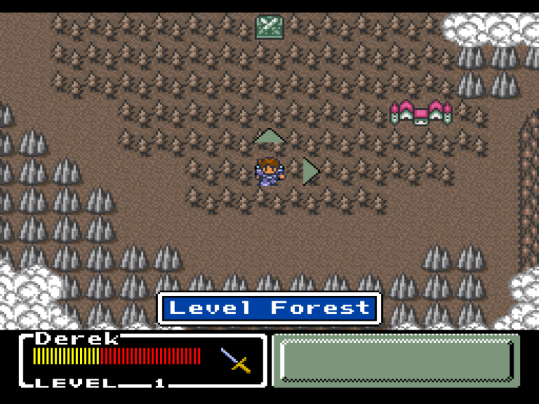
You just guide your little protagonist to the next area and go from there. You usually go to a town and talk to a bunch of NPCs and one of them will say something like “hey bro, go to the bone yard to get the earth crystal” and then a new map will open up for you to explore and you go from there. There’s no fear of getting lost or deciphering NPC dialogue to determine where certain towns are. I mean, as someone who gets lost all the time in real and fictional life, I certainly appreciate that there are people looking out for me. But this format really hampers this era of Final Fantasy where world exploration really feels like it’s part of the experience. A map of this style wouldn’t come around again until Final Fantasy X and X-2, where I feel it’s handled a lot better for what those games are going for.
Part of the leveling process of old Final Fantasy titles was running into random battles while you desperately searched for where to go next. Since that’s no longer the case, Square implemented 10 encounter long “battlefields” throughout the map. You just fight 10 battles, one at a time, and at the end you get an award…sometimes. Other times it’s just a bunch of EXP. So if you ever feel underleveled, just do those. I did them all because I hate myself and try to do every objective that comes across as long as it’s reasonable, but the average person can just skip these. I do not see ‘being underleveled’ as a problem many people will have with this game.
Probably the strangest part of this title is when at the very end you need to backtrack for an item called the Thunder Rock. Since you don’t need to get into an airship to fly to a different part of the world, you just move your character across the map city by city until you get to where you need to go. Then you go into the city, talk to the NPC, and then go back. There isn’t a boss battle, the NPC doesn’t give you any narrative, there’s no trick – you just get your item and that’s that. It takes like five minutes and I can’t understand the purpose of it. It’s like in a modern game when you need to flip a power switch but oh no! The power is out! You need to flow power to it in order for the switch to work! It just comes across as pointless padding.

“I never know when I’m going to get into a battle. Cecil will just be walking around and POW I’m in a fight. That’s so annoying, I’m just trying to become a Paladin.”
For the first time in the franchise, random battles are completely gone. Instead, you just see enemies on the world map. They are always in the same spot no matter what you do and they will always reload if you exit the dungeon or whatever you’re doing, but you can avoid excessive battles if you want to. Even though the implementation of encounters is kind of basic and makes the world feel very artificially created, it’s still nice to see this in a SNES Square game. They would later go on to do this better in Super Mario RPG. Really if you look at the basics of how this game operates and then compare it to Super Mario RPG, it’s very similar. One is just way better and actually did convince people to try this strange turn-based genre and the other is Mystic Quest.
For mainline Final Fantasy titles, non random encounters would not appear for quite a while. I don’t count XI in this because an MMO with random encounters seems absurd, so the first single player game you see this in is Final Fantasy XII. Encounters have been not-so-random since then. It’s interesting that they kept that staple of the franchise in for so long since other Square games like the aforementioned Mario RPG and Chrono Cross both ditched them.
“Why are there so many weapons here? Should Cecil use a sword? A bow? No weapons? It’s a little overwhelming.”
Early Final Fantasy games were pretty lenient with what they would allow your characters to use. With I and III it makes a lot of sense because those characters are just avatars for the player, but II and IV were pretty loose with it too. If you’re more familiar with later games in the franchise, you’ll know that they eventually migrated to a system where each character has a weapon dedicated to them. You can’t have Squall equip one of Quistis’s whips for example.
Mystic Quest dumbs this down to the point of just removing the ability to equip things entirely. Yes, you will find new weapons and armor, but they will just stack onto your character and replace what they had beforehand. If you get a sword upgrade, you can’t switch back to the old sword. You just have your new blade. Going to the equipment screen is just for reference. Your character has access to four weapons (sword, axe, a grappling hook-like thing and a bomb) and you can switch between them as much as you like by pressing R and L. In old Final Fantasy titles, flying enemies were often weak to bows but not very many other enemies had weaknesses related to physical attacks. That is not quite the case here, with multiple enemies having weaknesses to your various weapons. I would like to think this is to make up for how shallow the magic system is.
To me, the way this works comes across like an old Zelda game. I’m thinking Link’s Awakening here. You get your seashells and then you get your fancy new sword and the old one just vanishes. That works pretty well for a more action-focused game but in a turn-based RPG, I think it takes some of the player agency away. What if I wanted to have a challenge run and equip really weak items? I guess you could just avoid all treasure chests if you really wanted to but…oh who am I kidding, who the heck would try a challenge run of Mystic Quest?
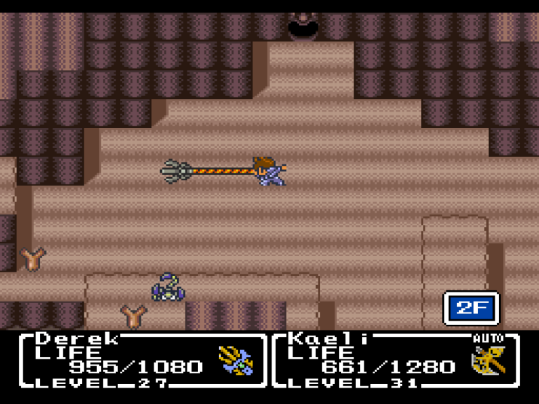
“The overworld is so boring. All you can do is walk and talk to people. You can’t even swing your sword out there!”
Speaking of Zelda, I feel this part of Mystic Quest was probably designed with games like Zelda in mind. In the overworld, your character can take various actions. You can swing your sword or axe, you can blow up certain rock or bone formations with your bombs or you can use your grappling hook-like-thing to climb up walls. You can also jump! This leads to some dungeons having some very light puzzle elements. Combined with how massive some of these places are – seriously the dungeons here are about as long as Final Fantasy II’s and definitely longer than most of IV’s – you have some really annoying levels.
My least favorite was probably the ice temple. This might have been my emulator legal SNES playing tricks on me, but this was the one place in the game where random encounters were turned back on. Enemies were still stationary but I couldn’t see them, so it felt like an older game. That dungeon was like a giant maze where you had to jump carefully over things, fall down multiple floors and flick switches with your sword to open new paths. Combining that with the non-random battles, it was probably the most miserable I have felt playing one of these games so far. I was trying to figure out where the hell to go and then every fifth step I’d have to fight some battle and it’d really break the flow of things.
The jumping thing leads to some really unfun positioning puzzles that require you to leave the area and come back in some way. They aren’t hard by any means, but with the glacially slow walking speed it sure is annoying putting blocks in the right place. This game would have been a lot more tolerable if it kept things simple. But hey, it’s neat that jumping made its debut here. The next Final Fantasy title to try that was X-2 and it was in very limited quantities. You couldn’t jump on will until XV. No, MMOs do not count.

“This story is too wacky. Some moon guy hypnotized some guy named Golbez and also Golbez is your brother? A little kid fell into some weird dimension and aged into an adult? What the fuck is a Namingway? Also those fakeout deaths had me sweating.”
MQ is like a meeting ground between NES-style Final Fantasy storytelling and the FFIV style. The overall narrative is very straight forward – the crystals have been shut off and the world is fucked and you need to fix everything. You go to four distinct areas and fight your new version of the four fiends and then you find out the true master behind it all and deal with him. NPCs have more dialogue here than they do in the older games, but it’s more flavor text than anything.
You don’t actually learn anything about your character though, he’s just a plucky brave kid trying to save the day. There are no character arcs to be seen here, but your entire cast is still well more defined than the main cast of II I suppose. It’s not bad or anything like that, it’s just exceptionally dull. It feels like a giant step backwards from Final Fantasy IV.
Now you might remember IV had a lot of fakeout deaths. I would like to think this was based on feedback from Final Fantasy II, but whatever. Some characters are gone for hours of game time only to pop back later.
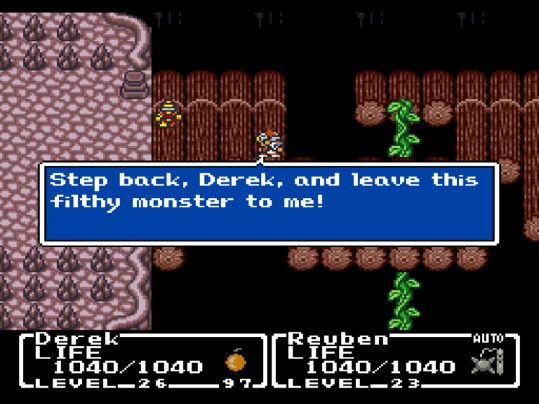
Here, there is exactly one time a character is seen to be in mortal danger. You’re walking along a bridge and some bad guys attack you. Your party member of the hour, Reuben, bravely sacrifices himself so you can escape. You aren’t even allowed to think he’s dead for a millisecond as the screen pans down so he can assure your protagonist that he’s okay and you just move on. Come on Reuben, the enemies in this area were kinda weak, I probably could have just cast White and finished them! There was no need for that kind of bravery!
“So if I lose and I didn’t save, that’s it? I lost hours of progress?”
Here is what the game over screen of Mystic Quest looks like:

If you click no, it just restarts the battle from the beginning. It’s a convenient feature because you will waltz your way into an accidental death or two, but it makes marching into any battle feel bereft of consequences. Going into battle and just mashing on the A-button over and over again will usually get the job done anyway, but if you blindly do it and get yourself killed, it’s cool. Just try again.
I think retries are fine. It’s just that this game is already so devoid of challenge that placing a little player inconvenience there wouldn’t really hurt. You can already save whenever you want, so even if you did die to a random battle, odds are you wouldn’t lose a whole lot of progress. Still, a feature like this is console generations ahead of its time. Very few games just send you back to the title screen anymore. It’s just a little weird to see such convenience in a 90s RPG for the SNES.

“That music sure kicks ass”
You’re damn right it does and I can say that Mystic Quest also has an excellent soundtrack. The main composer credited is Ryuji Sasai and he turns in a performance that is different from what you’d hear from Nobuo Uematsu, but is still one that you won’t want to mute.
youtube
I’ve mentioned the walking speed very briefly before, but let me reiterate: it’s slow. Like, heinously so, to the point that I think most players would probably drop this game without utlizing an emulator’s fast forward function. If this game had a bad soundtrack, I truly believe most people would bail in order to play something a little more fast paced. The music here truly carries MQ and in some ways saves it. This is a game almost nobody talks about anymore and yet it earned a place in the most recent Theatrythm (Final Fantasy rhythm game) title. That’s impressive! I don’t think it’s a top-tier Final Fantasy OST by any means but it could have been so much worse. Like, have you played Sonic Chronicles: The Dark Brotherhood? …If not, please don’t.
While I may have come off as slightly harsh on this game, please understand that there are things I do like about it. It’s not one of the worst games ever made, or even close to it really, but it’s painfully boring and slow. It feels like a weird missing link between the Famicom titles and Final Fantasy IV, even though it was released AFTER IV came out. The cover art does say “Entry-Level Role Playing Adventure” so I guess they do try to warn you a little bit.
Notable characters
For the playable characters, this title does not include character portraits like the mainline games do. So I grabbed character portraits from the instruction manual (thanks to the Final Fantasy wiki) so you could get an idea as to what your heroes are supposed to look like. The chibified character art is pretty common in the series up to this point, as seen in the Super Famicom cover for Final Fantasy IV.

I like that the art style can at least be tied to the original series.
Protagonist

Here is the very first screen you are greeted with in Final Fantasy: Mystic Quest
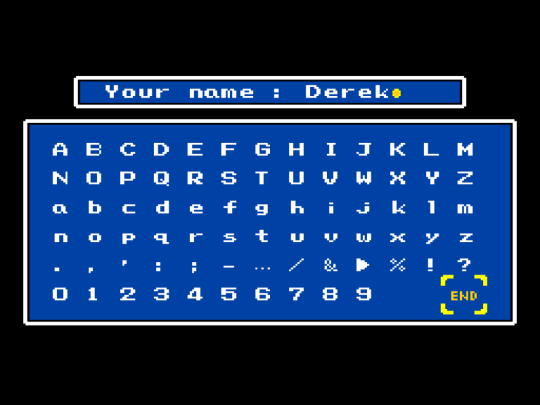
It starts out totally blank, implying that there is no true name for this fella. However, if you open the instruction manual, you will find out that his name is Benjamin. Very cool. I decided to just name him after myself, like any good middle schooler would do. “Benjamin” is the only character in the game that you get to name. So if you wanted a group of you and your best bros to take on the Dark King, well, too bad. I have referred to him as ‘the protagonist’ up to this point in this retrospective, so I will continue to do so. Though if I accidentally call him Benjamin, Benny, Ben or Benmothy…I apologize.
The journey starts with your main character’s village getting destroyed by an earthquake. A mysterious old man shows up and tells him that this is because a group of villains called the “Vile Four” stole the power of the crystals and locked up the Focus Tower, which is at the center of the world and basically brings everyone together.
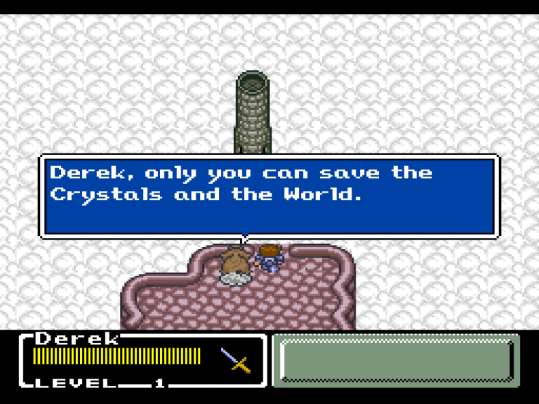
The old man says that there is a prophecy that states a hero will show up and save the world and wouldn’t you know it, the old fella thinks you’re that hero. Exciting!
The protagonist is the only character you have complete control of for the entire game and yet he spends a lot of the game being outclassed by your other party members because they always join like five-or-so levels above what your protagonist currently is. This changes in the late game when your protagonist has the best magic, but until that point your buddies will often be more useful than you are. Some legendary hero! I guess he’s by far the most useful character by the end of things, so it all works out.
Kaeli

Early on in the game, the protagonist travels to the Level Forest – a bad name for one of the first areas in the game, made me think the fire area would be called Level Lava or something – and discovers it is in bad shape. He takes a withered branch and presents it to Kaeli who is something of a nature lover and vows to go to the forest and help you fix it. It’s unveiled that an evil minotaur is poisoning everything in the vicinity and he also poisons Kaeli, but that doesn’t stop her from helping you send the Minotaur packing to save the forest. She still collapses from all this and your main character must now focus on saving her! Wouldn’t you know it though, the cure for her illness is in the BONE DUNGEON which is also where your first crystal is. How about that! Her illness leads to one of my favorite exchanges in the game.
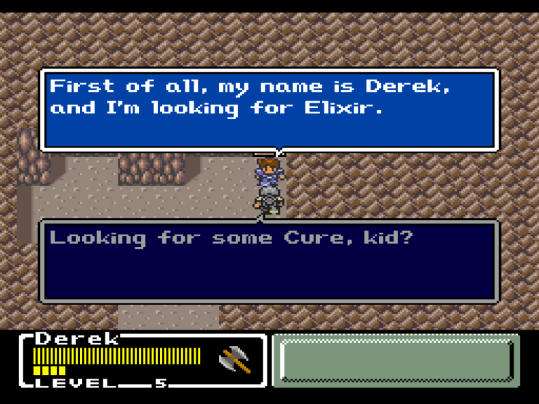
It gives me some serious “LOOK MOM IT’S A DIGIMON, IT’S NOT A POKEMON, THEY ARE DIFFERENT.”
Kaeli’s defining combat characteristic is that she has an axe. It makes her very useful against creatures of the forest, like evil trees, because they are weak to axes. She comes back later in the game with an even better axe to use against even more evil trees. Heck, you enter a giant tree during her return to root out the evil in th…wait a minute, did Ocarina of Time steal from Mystic Quest!?
I think they hint a couple of times about her having romantic feelings towards the protagonist, but I might have been trying to find a character where there wasn’t one.
Tristam

Your mandatory ninja companion! You meet him while trying to save Kaeli and he agrees to let you have the elixir if you help him clear out the BONE DUNGEON. This works out because, as I said, the earth crystal is there. He sells you explosives once you get there, which will go on to become one of the most important items in the game.
When you get your single fake death in the game, Tristam rejoins you very briefly. Like 20 minutes later you run into another character who says he might have found a treasure somewhere and Tristam immediately takes him at his word and fucks off for the rest of the game. Well until the credits. I had a good laugh at him leaving you at the mere suggestion of treasure though. Maybe this fella was inspiration for everybody’s favorite Final Fantasy ninja, Yuffie Kisaragi.
Tristam uses ninja stars, which are not an infinite resource. I never ever came close to running out of ninja stars so I don’t know what happens if you ever do, but the number ticks down every time you attack so I figure it’s worth noting. He teases you early on with a grappling hook only to just give you one for free later on, which is very nice of him.
Tristam is probably in your party less than any other character in the game and that probably makes him my favorite one. As they say, absence makes the heart grow fonder!
Phoebe
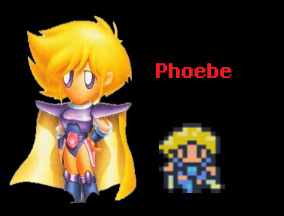
You meet Phoebe while you are trying to find your second crystal. Her hometown, Aquaria, has been frozen over because the water temple has been taken over by an evil Ice Golem in the Ice Pyramid. Killing the golem frees Aquaria. Phoebe is the character you probably have in your party the most, simply because she is your companion for the final boss of the game, the Dark King. You’d think it would give her more of a character, but no. The only thing you need to know about Phoebe is that she loves her town and that her grandfather likes to dig a lot.
From a gameplay perspective, Phoebe hits really hard with her arrows and has the highest magic stats in the game. She has access to a wizard spell in thunder, which is extremely useful when you recruit her. During the final stretch of the game, she gets access to the White spell and has 10 wizard charges which is really nice. But for me, she was basically just around to heal the protagonist if he got put under a status effect or something. He has access to more powerful skills, so even if his magic stats are technically weaker, he still is more valuable than Phoebe because Phoebe can’t cast flare.
She’s also your partner during the most annoying part of the game, which most definitely put her in a negative light in my eyes. I cannot stress how much I hated the Ice Pyramid.
Reuben

Your final party member! Hey you make four friends and the main bad guys are called “The Vile Four.” Do you think there’s a correlation there? Who can say. You meet Reuben when you’re trying to find the fire crystal. He tells you his dad knows where it is, but his dad is trapped behind a boulder somewhere and he needs your help to save him! So everyone wins by this alliance. Reuben is the first party member you get who doesn’t seem like he wants to ditch you, so the game invents a reason for him to ditch you by giving him the half-a-second fakeout death I mentioned above. How rude. He comes back later to help you reach the final dungeon but quickly leaves again.
Reuben hits really hard but his magic skills aren’t terribly useful. The first time you get access to him, the only spell he knows is Life. Life is handy in case an emergency happens, but it’s not something you would get a use out of in every encounter. He returns with White much later on, but much like Phoebe, by the time he returns to the protagonist, your main character is just too strong. He’s there to support and keep ya moving. By the end of the game, I was pretty ready for it to be over so maybe I’m being unfair to these guys, but if the protagonist can solo most everything so efficiently, why would I shake things up?
Spencer

When grabbing screens for this game, I forgot to grab some for characters I thought were important. Every single stinking picture of Spencer I have in my FINAL FANTASY: MYSTIC QUEST folder is from a side profile, the end of the game with the entire main cast that would be really weird to use here or from the back like this. So I went ahead and attached my favorite Spencer screen and just hastily placed front-facing Spencer on there. There might be one or two more guys I do this with. Plus I just love this dialogue exchange because Spencer just likes digging. Dudes rock, ya know?
Spencer is Phoebe’s grandfather. He is trying to dig a tunnel from underneath Phoebe’s hometown of Aquaria all the way to a lake where another important character, Captain Mac, is trapped. The goal of this is to get Aquaria’s water into the dried lake where Mac is stuck. A one man digging operation seems like the most efficient way to do this, sure. Unfortunately Aquaria is frozen over when you reach that area and Spencer is trapped down in his little tunnel. Not to worry, his plight is why Phoebe joins your party, so his suffering is your gain. When Spencer gets free, our good friend Tristam lures him away from his work with the promise of a treasure hunt. He bails and then in the best scene of the whole game, Phoebe gets frustrated and throws a bomb in an effort to complete the tunnel really quickly but this fails and just destroys this guy’s hard work.
Despite not really needing his zany tunnel anymore, he goes back to it at the end of the game to continue digging. Even though Spencer doesn’t get a ton of dialogue, he came across as a crazy old coot (kinda like FFIV’s take on Cid) to me and I found him very charming.
Arion

This Indiana Jones looking guy is Arion. He is Reuben’s father and a major reason why that particular rapscallion joins your party. Just like with Spencer, the crystals going haywire has trapped him somewhere. In Arion’s case, he’s trapped behind a boulder that can only be destroyed by mega grenades (an upgrade for your bombs that Tristam so nicely hooked you up with). Once you save him, he just tells you where the Fire Crystal is, which allows you to finish up your journey through the fire nation.
Arion is also the NPC that you have to visit for that garbage fetch quest I mentioned above regarding the thunder rock, so I am inclined to dislike him a little bit.
Otto

This guy’s full name is apparently Otto CID Bekenstein. That’s right, even Mystic Quest has a Cid! Now I didn’t encounter this anywhere in the game myself, but I read it online and I choose to believe it. It also makes sense because Cid is a mechanic which falls in line with every single incarnation of Cid ever up until this point.
Otto operates a machine that generates a rainbow road, which would help the party get to the wind crystal that is located in Pazuzu’s tower and doubles as a sick go-kart track. Pazuzu is one of the Vile Four, for the record. His daughter just so happens to be trapped there too, but unfortunately there is a lot of wind disturbance going around and his machine is broken so he tasks your crew with fixing that and then saving his daughter. He’s also involved with the thunder stone fetch quest I mentioned earlier, so I can’t say that I’m a fan.
Since this is the last time I’ll mention it, I’ll just explain it real quick. The thunder stone is used to power up the rainbow bridge machine so that the bridge extends to Spencer’s zany tunnel, which allows your party to get to Captain Mac and his boat, which then allows you to get to the end of the game. Cool? Cool.
Captain Mac

Mac is Kaeli’s father and goes on an expedition at the start of the game to learn more about the prophecy that states a warrior will take down the Vile Four and restore the crystals. Unfortunately while he is sailing, crystal shenanigans occur and his boat is stranded in a dry lake. Using the powered up rainbow machine, your protagonist proceeds to set off another bomb in Spencer’s place which floods the lake Mac’s boat is stuck in. Whenever you reach the captain, he informs you that there was more to the prophecy than anybody realized. He states that the true fiend behind this is someone who is commanding the Vile Four: The Dark King. You then can take his boat, head to Focus Tower and finish the game.
Mac is strange because I feel like the game talks a lot about him before he shows up, but when looking over my notes while writing this section, I have towards the end “I still don’t really know who Mac is.” He’s important because he unveils the mastermind of everything, but I’m not sure how everybody in the world knows who he is or why Spencer is trying desperately to save him. I guess all we need to know is 1. he’s an explorer 2. he’s Kaeli’s dad 3. he has found some neat information and 4. he gives you his boat.
White or "Mysterious old guy"
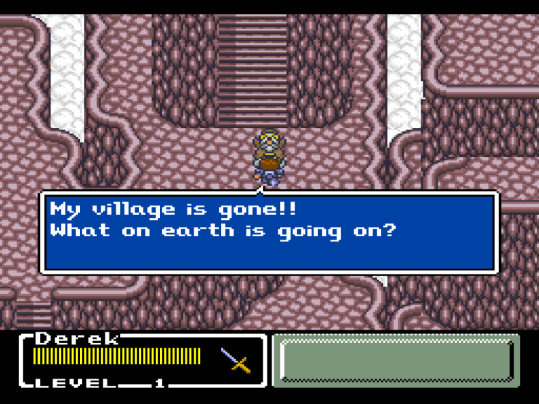
Throughout your journey to save the crystals and the world, a weird old guy will pop in and give you vague information and then go away. He seems to know a lot about the workings of this world and he shows up a lot to sort of guide you along. You might even briefly think that he knows too much, but at the end of the game the nature of the mysterious old man is revealed.
He’s a crystal! Like, you know, one of the tentpoles of the franchise at this point? Kind of an interesting idea for a character reveal because it makes sense that a crystal would be interested in saving the crystals, but I wish this idea had been explored in a Final Fantasy game that actually has an interesting narrative. Wait…I activated and rescued all four crystals. How could he contact me while deactivat-
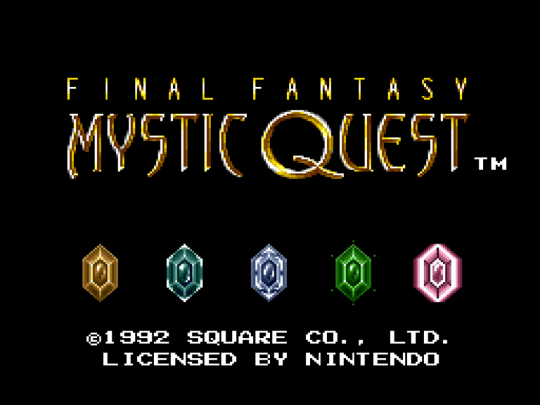
The title screen hinted at this. Five crystals! It’s right there! Well played.
The Vile Four
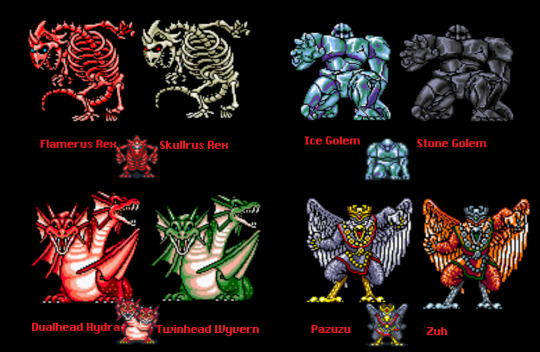
The Four Fiends return again and just like in the Famicom titles, they even come back from the dead at the very end of the game as part of a little boss gauntlet during the final dungeon. In the above compilation, the original bad guy is on the left while the revived one is on the right. The little fella in the middle is the overworld sprite of the original encounter. The final dungeon is probably my favorite dungeon of the game because it reminds me of Hyrule Castle in Ocarina of Time. What I mean by that is it’s comprised of tiny bite-size portions of the major dungeons you’ve encountered so far. This part of the game is pretty straight forward, so even the annoying ice pyramid isn’t so bad when it only lasts two screens. I’m just a sucker for when a game puts you through a microcosm of itself. It’s a trip down memory lane!
As for the boss fights themselves? They all kind of run together. The only one that requires any strategy is Pazuzu because there is a brief period during battle where he will counter your magic abilities. It is one of the few times the game outright forces you to ‘strategize’ so it stands out. The rest are just ‘cast a big spell and heal’ so I will take what I can get.
The Dark King
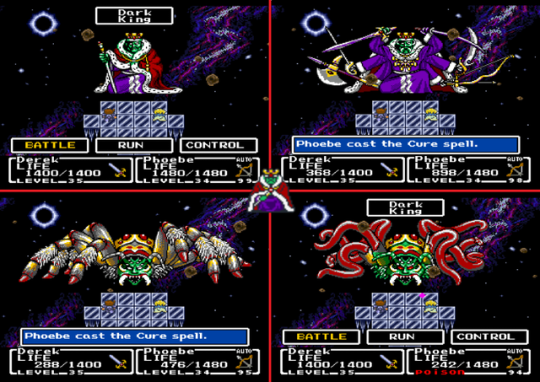
Here’s the final boss of the game. He’s the only baddie in MQ with multiple forms. He has four of them and in the little grid above they are ordered clockwise starting in the top left. There doesn’t seem to be any differences in the four forms as far as combat goes, so just look at it as a way to tell your progression. My favorite one is his second form because he looks like a poor man’s Gilgamesh from other Final Fantasy titles. Just like every other non-Pazuzu boss, all you need to do is hit him hard and heal and you’ll be fine. Somehow he is harder than the final boss of Final Fantasy II, but to be fair I used a blood sword when dealing with that boss so I might have had an unfair advantage.
As our good friend Captain Mac told us, the Dark King is the one behind everything. He’s the key to all of this. He has basically no personality outside of “boss of the bad guys.” It’s not quite a Necron situation because you’re explicitly told he’s the main bad guy by Mac before the final dungeon even starts and wait shouldn’t White have told you about him? He should know about this guy! Oh whatever. He’s evil and you need to kill him. Simple as that.
It started here
I’m not going to pretend later Final Fantasy games pilfered ideas from Mystic Quest, but I still wanted to point a couple of things out. Think of these as an early cameo.
No overworld, retries instead of a game over
Both mentioned above. The no overworld thing is interesting because every mainline Final Fantasy title would have one until Final Fantasy X. Then they just kinda vanish until Final Fantasy XV. That’s not to say other SquareSoft titles evaded an overworld, the other beginner friendly Square title Super Mario RPG also chose to go with a level select screen, but it’s definitely interesting to see a SNES title with Final Fantasy branding just not have that.
Battle damage
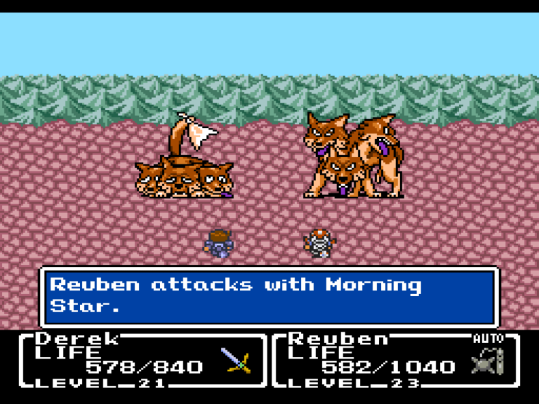
I would like to think focus groups were bothered by how you just can’t tell how much health random enemies have (without casting magic that explicitly tells you), so their solution to this problem was having enemies have different sprites based on how much health they have. It’s fun when you one-hit a bad guy because their battle damaged form will pop up very briefly before they vanish entirely. It’s actually admirable how they gave every enemy multiple sprites because not even later Final Fantasy games do that, usually the only characters to show a ‘weakened’ state are boss monsters. Going back to Final Fantasy X, a lot of bosses show fatigue when they’re close to going down but I can’t think of a single regular encounter that has enemies acting differently when they’re about to die. Mighta been kinda nice for when you’re fighting Sand worms or a Zu, ya know?
My favorite sprite in the game is the werewolf as seen above (you thought I forgot about that in my character recap? hah!) He’s CLEARLY waving a white flag. He’s surrendering to you! And yet the protagonist must wail away on him anyway to get that sweet EXP. My second favorite is the little Edgehog because it looks like he got a bad haircut. It’s cute.
Bosses have multiple damage sprites, which helps give character to those battles and helps those characters stand out from the rank-and-file. Hey man, the battles themselves aren’t that interesting so they gotta do something, right? The Dark King seems to eschew battle damage to give you forms, which I think is a poor substitution because it just makes the Dark King stand out as the only bad guy in the game who doesn’t show proof of your prowess.
Spin-offs
Now you might try to take me to task by claiming that Final Fantasy Legend or Final Fantasy Adventure count as the first spin-off titles but I disagree. Those were SaGa and Mana games that got rechristened so a North American audience might be willing to try something new. Mystic Quest, from the ground up, was designed to be a Final Fantasy spin-off title. It may not be the greatest game ever, but there are roughly 83,000,000 Final Fantasy spin-off titles now and this is where they start.
Before you ask, no, I’m not going to do retrospectives on every Final Fantasy spin-off game. The only other one I plan on doing right now is Final Fantasy Tactics. I will be doing select sequels (like X-2), but I don’t consider those spin-offs. I chose to recap Mystic Quest because it was the first major spin-off title and it is also what Westerners got instead of Final Fantasy V.
In conclusion
This is likely a game many people wouldn’t even bother with (myself included) if the words FINAL FANTASY were missing from the title. It’s a game that would probably be forgotten to history if it wasn’t for those two simple words. It’s not absolutely horrible by any means, it’s just dull and forgettable. A middling title in a sea of more interesting Super Nintendo games.
I think if Square’s aim was to get Western children into RPGs, this was a bad way to do it. They would eventually figure it out with Super Mario RPG, but I don’t think a playthrough of Mystic Quest would convince anybody to try out Final Fantasy IV or the relatively soon-to-be-released Final Fantasy VI.

#Final Fantasy#Final Fantasy: Mystic Quest#Final Fantasy retrospectives#video games#vidya thoughts#opinion#super nintendo#squaresoft#square enix#retro gaming
1 note
·
View note
Text
Final Fantasy IV: The Next Generation
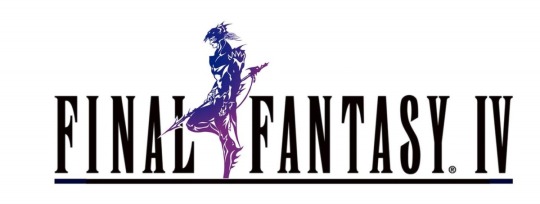
View On WordPress
#Final Fantasy#Final Fantasy IV#Final Fantasy Retrospectives#jrpgs#opinion#ps5#rambling#retro#SNES#Super Famicom#video games#vidya#vidya thoughts
1 note
·
View note
Text
The Best Sort of Sendoff
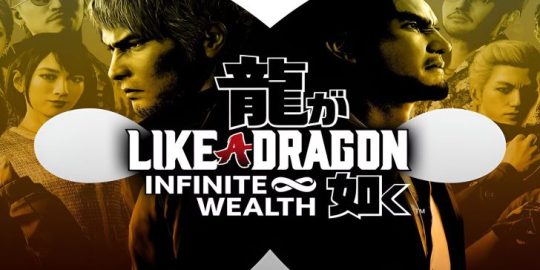
Note: This article contains spoilers for Like a Dragon: Infinite Wealth. For reference, I am in Chapter 10 of the game right now, so this won't contain end-game spoilers. This is instead a look at what happens in the "Memoirs of a Dragon" portion of the game. It's risky writing this before I finish playing, after all this is the franchise that used rubber bullets as a plot twist, but I have faith in the writers to not suddenly drop the ball.
In most films in the Rocky franchise after the first two, there would be a scene where Rocky looks back on his past and you get a great montage of scenes. They would show his triumphs, his hardships and generally make you feel good for following his story up to this point. I would like to think this is because Sylvester Stallone never knew when the final Rocky movie was actually going to be. Rocky Balboa was a legendary character, the movie's world isn't the only thing bidding farewell to him - the audience is too.
Saying goodbye to a character the audience has spent a lot of time with is a tricky thing to do. One of the main complaints about the Disney Star Wars films are how they treat characters from the original trilogy. Return of the Jedi had a pretty happy ending for the main cast but fast forward to the sequel trilogy and everybody is miserable, their lives suck and they die in a way that left a lot of people feeling unfulfilled. Regardless of what you think about the quality of these films, the treatment of these characters is a gigantic reason the reception towards them is so chilled.
The Like a Dragon franchise has not had Kazuma Kiryu as its main protagonist for two games now. Yakuza: Like a Dragon, the seventh entry in the franchise, replaced him with a character that feels like his polar opposite. Kiryu is stoic and keeps a lot of things internalized, Ichiban Kasuga is loud and personable and wears his heart on his sleeve. They both come across as good people but in different ways. Kiryu did get to show up in that seventh entry, but he felt like more of a cameo role. It was like getting to spend one more afternoon with the living legend. It wasn't his show anymore, but he was around.
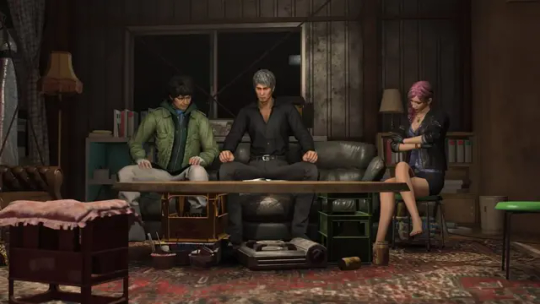
Little did we know when playing those games that Kiryu would get a farewell tour. Like a Dragon Gaiden: The Man Who Erased His Name kicked this all off with a nice little side story about Kiryu living life as a man who is supposed to be dead. It's mostly a standalone piece, but the references to Kiryu's past adventures come hitting hard and fast at the very end. I wrote that the ending to that game is a masterclass in video game storytelling and I stand by that - if you've stuck with Kiryu through all his adventures so far, it is one of the best scenes the medium has ever conveyed.
There wasn't a sense of finality though. That title ended with Kiryu saying he wanted to live a little bit for himself. He was already a major part of the ad campaign for the eighth entry in the franchise, Like a Dragon: Infinite Wealth, so there was no feeling that we were saying farewell to this guy. In a sense, we would be getting a new chapter for this legendary figure. Rocky Balboa would be getting one final fight in that ring.
Infinite Wealth gives you that finality. Kiryu shows up and it is revealed that he has cancer and only has months to live. While he is still an imposing and larger than life figure, his time on this earth is up. He doesn't seem too bothered about it though. The audience might be going like "hey dude, why don't you reconnect with Haruka or something?" but the man himself just wants to accomplish this last mission he is on and die in peace. You spend a long time in Infinite Wealth going around Hawaii with the future and past of the franchise yucking it up and it just feels great. Chocolate and Peanut Butter together at last!
At some point in the game, Kiryu's illness gets the better of him and he is sent back to Japan to take it easier. Given that he has months to live, he shouldn't be fighting baddies with Kasuga all day and night, he should be resting. Who knows, he may have more time than he thinks! At this point, the game decides to start letting the player say goodbye to this character. Your party and Kiryu's old friend Makoto Date note that the dragon of Dojima has spent the majority of his life looking out for others and should really spend his last moments doing something for himself. That's right, Kiryu gets to star in the hit 2007 film "The Bucket List"
The game then opens up a bit of story called "memoirs of a dragon" as part of this bucket list. You guide Kiryu to a bunch of locations in Japan, both in Ijincho and the very familiar Kamurocho, and relive all sorts of things. It's one thing seeing the gate in front of Tenkaichi Street and going 'oh yeah, I've seen that gate before, it's in every single one of these stinkin' games,' it's another thing to have your main character reminisce about this and what it means to him. Sure, a lot of time media can best convey emotions by showing and not telling, but hearing your fading protagonist talk about the old days gives you more insight into those things and can help the player feel a little bit more.
These scenes vary greatly in their emotional impact. Some of them are goofy, with call backs to side games like Yakuza Dead Souls or Like a Dragon: Ishin. Some of them are sweet, with our protagonist talking about characters who don't even seem to appear in this game like Goro Majima or Taiga Saejima or Shun Akiyama. If you played past Yakuza games, you know who these guys are and it's nice to see them acknowledged in some way even if they don't play a major role here. You remember them and Kiryu does too. This is a memory of his life, not just a memory of what you experienced in Infinite Wealth to this point.
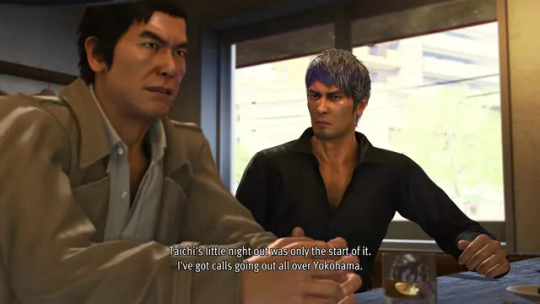
At some point, Kiryu's friend Date decides that this whole process needs to get a little more personal. You see, the Dragon of Dojima is supposed to be a dead man. He fakes his own death in order to protect his loved ones because he was privy to some government secrets that put everyone in danger. So Date decides to gather some people and have Kiryu sort of listen in on their conversations so he can see how they're doing without him. The conversation almost always circle back to Kiryu and how awesome he is (was), so it can feel a bit like Tom Sawyer listening in on his own funeral, but it's sweet hearing people give their thoughts nonetheless.
Sometimes Kiryu will interact with these people, but he never actually explicitly says who he is. He'll say he's Taichi Suzuki and leave it at that. You get the impression that everybody knows it's really him, so they'll say really emotional things that start with phrases like "well if he was here, I'd say something like..." It's just very sweet to get a sense of closure with characters that normally would just be one and done. You never got to see Rocky Balboa get one more chat with Clubber Lang well after the fact, but longtime minor foe Lau Ka Long sure as hell gets one final moment to see the legendary yakuza one more time.
All of these scenes are a really nice look back on this guy's life. The player gets to be privy to a lot of introspection and dialogue they normally wouldn't get to be a part of. The best part of this is, you never get the impression Kiryu is a miserable person who isn't ready to go out. He instead goes with the approach of "I thought I had finished all I needed to do, but getting this extra closure has been really nice." It's incredibly sweet to see orphan boy Taichi as a grownup and doing well for himself. As players, we saw this fella when he was just a little brat at the orphanage. Kiryu put on a wrestling match for him! The last time Kiryu saw him was when he was a child too, so this little scene is great because both the protagonist and the player get to see this long gone character and go "his life seems pretty neat."

Probably the most impactful scene I had gotten to at this point would be Kiryu seeing Kaoru Sayama one final time. For those that don't remember, Sayama was Kiryu's love interest in the second Yakuza title and the two of them ended up parting ways because of different goals in life. It was always sad to me, personally, as a player that she got written off and just vanished into the void but here she was once again. And yeah, her life is going great! She's working hard to help ensure that the youth don't go down the wrong path, she made a good life for herself in America.
But Date hones in on her lack of a wedding ring and it is revealed that, yeah, she keeps kinda busy so it's hard to find someone. But also a part of her wants to stay available just in case Kiryu really is alive, as a lot of people whisper in the underground. Date almost lets it spill that well he's actually still there, but Kiryu (communicating via secret spy headset so he can listen in) stops him and says it's not necessary. Later on he says something like "to know she still cares is more than enough for me" and that his current situation would just make things worse for her. He isn't regretting his past choice of parting from her here, he is instead appreciative of the person she has become.
Being able to see and hear all of the impact this character has had is really something special. You've spent hundreds of hours as Kiryu talking to all these characters. You're not only saying goodbye to this legendary video game character, you are also saying goodbye to his world and the people he cared about. This isn't just a farewell to Kiryu, it's a farewell to the old.
By not portraying Kiryu as a miserable sadsack on death's door but instead showing him as a man ready to face death head on, the writers of this title really make this feel like an excellent farewell. He doesn't need to be in a Wonderful Life scenario where everyone tells him how important he is, but he gets to experience it anyway and appreciate it. It's a final gift for a man on his way out. These characters aren't trying to redeem Kiryu or make you see him in a different way, they are simply reaffirming what you the player already know: that he's awesome.
We will probably never see a character get as great of a sendoff as this again. There will not be an Uncharted game in 10 years where you get to revisit all the old characters and see where life has taken them. So appreciate this for what it is - another great example of storytelling in video games.
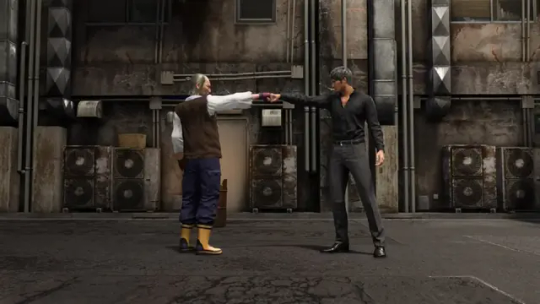
#Like a Dragon#Yakuza#Like a Dragon: Infinite Wealth#video games#PS5#Xbox Series#PC#JRPGs#vidya#vidya thoughts#video game thoughts#rambling#opinion
2 notes
·
View notes
Text
Final Fantasy III: End of the Famicom Era
Moving on from II
Final Fantasy III was unleashed on the masses on April 27, 1990. It was the last Final Fantasy title to appear on the Famicom/NES. The Super Famicom/SNES was around the corner, so it was no surprise that this would be the final entry of the fledgling franchise to appear on Nintendo’s first console.
From a business perspective, Final Fantasy II performed pretty well, selling…

View On WordPress
#console games#Final Fantasy#Final Fantasy III#Final Fantasy Retrospectives#jrpgs#rambling#retro#retro games#retro gaming#rpgs#video games
0 notes
Text
Kingdom Hearts: Chain of Memories does not get enough love
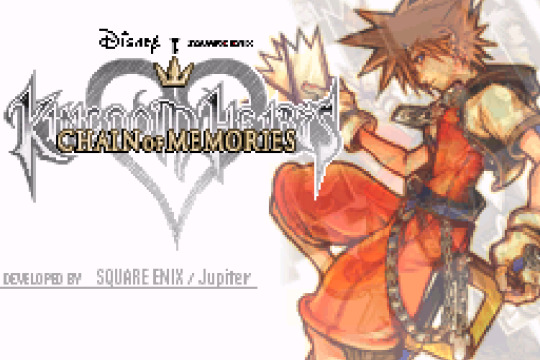
When hearing people talk about the first few Kingdom Hearts games, there is often a feeling of annoyance that they need to play Chain of Memories in order to fully understand and appreciate Kingdom Hearts 2. I've seen a lot of people suggest looking up youtube videos of Chain of Memories runs as a sort of replacement for experiencing the story.
This is baffling to me. Chain of Memories is not some black sheep game that ruins the reputation of the franchise. You want a game that actively hurts a franchise by existing? Go look up Lunar Dragon Song and then cry yourself to sleep because you just looked up footage of Lunar Dragon Song.
For reference, Chain of Memories is the true ‘second’ Kingdom Hearts title despite lacking the number 2. It bridges the gap between the closing moments of the original game and the opening bits of Kingdom Hearts 2. It’s an important piece to the franchise’s narrative. For a lot of people, the story of 2 is confusing because they skipped over Chain of Memories. This is an important game a lot of people like to downplay the importance of.
I would like to blame the PS2 remake of Chain of Memories, RE:Chain of Memories, for this perception because it took a 2D game and converted it to 3D without thinking too much about it beyond the presentation. It doesn't help that this is the most easily accessible version of the game, considering it has been ported several times as part of the Kingdom Hearts 1.5 HD collection. If we're just talking about that game, yeah, it does feel like kind of a slog. But it's not the end of the story, it should not be the only version of the game people remember or talk about. The original version, released on the Gameboy Advance, should receive some love.

For those unfamiliar, the gameplay of Chain of Memories is a bit of a departure from the original Kingdom Hearts. This is likely due to system limitations. It would be really hard to make a game that plays like Kingdom Hearts on a system with two face buttons and graphical fidelity closer to a SNES than a Playstation 2. Your skill set is completely tied to a deck of cards. You can't just swing a keyblade, you have to have a keyblade card. Cards come numbered 0-9 with higher number cards cancelling out lower number cards - though the number 0 cancels out everything. So if Sora uses a card with a number of 6 and an enemy uses a card with a number of 7, Sora's attack will be cancelled out and the enemy's attack will take priority.
You also have a card point system for deck building. All of your cards are given point values related to how strong they are. So let's say your card point system cap is 100 - you need to make a deck to fight that works within those constraints. So you have to ask yourself such questions like "Would I rather have a few hard hitting cards? Or do I want more attack options that might be a bit weaker and easier to break?" You also have to think about magic and item cards, so just blindly slapping together a deck full of a bunch of cards with the number "9" on them probably won't get you very far. You need to think.
As you level up, your card points increase and you can build larger decks. You can also learn special moves that involve combining cards in order to use special attacks, or sleights. So deck building evolves from being "do I want fewer strong cards or more weak cards?" to "how can I make a balanced deck that lets me hit hard and use all these techniques I have?" It leads to a surprising amount of strategy in combat, particularly in boss battles. What if a boss uses a lot of sleights against you? Combining cards will give you a large number, naturally, so the natural counter to that would be to use a lot of cards with a value of 0. Remember, cards with 0 cancel everything out. So on an initial playthrough, a lot of boss fights will involve studying how your opponent uses cards and finding a strategy that works against how they act.

Using sleights yourself makes you lose the first card you sacrifice for that combination, so you have to build your decks with that limitation in mind. You have a spell called super flare that involves using the summon Mushu and two fire cards. When you use it, you will always lose a Mushu card. So do you want to be able to use super flare multiple times and carry multiple Mushus (expensive cards that can take over 30 card points to assign to your deck)? Or would you rather find alternate abilities to use? It's a deep and confusing sounding system, but once you actually get your hands on it, it makes sense and I would compare it to a more traditional deck building game like the Pokemon Trading Card Game. You just have to think a little.
I mentioned boss battles briefly and what makes them so interesting in this game is that the bosses have the same restrictions you do. When they use sleights, they lose a card. They have to reload their decks when they run out of cards. They can counter you just like you can counter them. It feels like a duel against another person instead of a fight against a computer opponent that has advantages not available to the player.
When you finish the game, you unlock a mode where you play through the game again as Riku. Instead of just being the same deck building experience, it's something else entirely - you cannot edit your deck at all. It's an exercise on how well you can adapt to fights with a premade deck. There are some levels where you have like six cards to work with and you have to figure it out for yourself - the mechanic can almost make certain fights feel like puzzles. You can legitimately run out of attack options if you use too many sleights, so you have to really think about what you do. It's an interesting twist from the standard formula and I actually find it preferable to the main mode of play because it's a test of your ability to adapt.
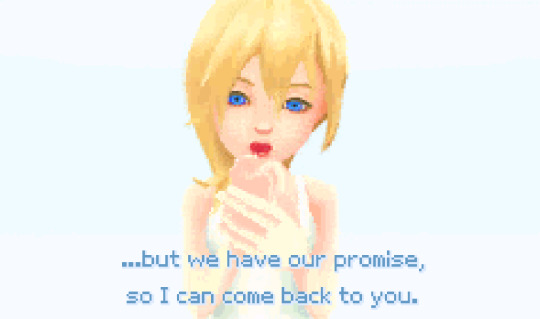
Now it's time to activate my inner crotchety old man. Part of the appeal of SquareSoft/Square Enix games on the PS2 was how cutting edge they looked for their platform. When you got to a cutscene in Final Fantasy X it legitimately felt like you were living in the far flung future. In modern times, cutscenes kinda just look like normal gameplay scenes most of the time, so they don't feel as special. If you can believe it, they were able to replicate this feeling on the GameBoy Advance.
Square included a couple of prerendered cutscenes into the mix that play at certain times. Yes, what shows up is nowhere near as visually impressive as what you would get on a PS2, but on a smaller screen it looked close enough and it felt like sorcery seeing your little GBA screen pull off what appeared to be PS2-caliber graphics. Yeah, it's a trick because the Gameboy Advance isn't actually rendering this stuff and it's just a little compressed video, but this trickery went a long way and totally blew my mind. Also, the full version of Simple and Clean plays over the end credits. No midi junk, it feels like the same thing. It's hard to express this to people who weren't there to experience it, but the experience on a handheld felt magical.
This is just lost in the transition to 3D. Everything looks the same kind of good. It's not some magical little game from the future, it's just a budget PS2 game designed to explain to people just who the hell Namine is.
Now something that isn't console dependent is the game's story. You would think that the weird handheld game released on a different console than the main series would have a throw away filler story that wasn't important to the overall plot of the franchise but you would be dead wrong. Chain of Memories started the tradition of "if we release a game, it matters." It persists to this day because there are scenes in Kingdom Hearts 3 that don't make much sense unless you've spent time with the mobile games. It can be kind of annoying if you don't like the type of game you're supposed to play, but I think it tells the player that 'nothing we put out is half baked, it all means something.' Nothing feels like filler, even though it very easily could.

I think the story told is really interesting and the way it details Sora slowly losing his memories is fairly well done. At some point Sora just stops talking about Kairi and all mentions of her are replaced by Namine to the point that he becomes obsessed. It starts out really slowly but eventually Sora's dialogue becomes extremely focused on this character the player had never heard of before. It's just a really interesting bit of characterization. Also, it explains why the hell he is in some alien pod at the start of Kingdom Hearts 2.
It also does a very good job of characterizing the members of Organization XIII that appear here. In Kingdom Hearts 2, I don't feel like the highlighted organization members get that much time to unveil their personalities. There's a little of it, but what can you tell me about Demyx's actual personality beyond DANCE WATER DANCE? In Chain of Memories, I feel like Larxene, Vexen, Marluxia and Axel all get developed quite well. They feel like real characters, to the point that before the organization members were expanded on in later games, I preferred the CoM characters because they all seemed really interesting. I was sad Larxene wasn't in II because she was a lot more interesting than Xigbar (please note these are the early days of the franchise) or Demyx or Luxord.
Truth be told though, the Sora portion of this story is easy enough to understand via context clues, but the Riku part of the story is very crucial to his character. It's an interesting look into how he views darkness as a necessity and not as an evil - it makes his struggles with darkness in 2 a little more interesting. I think CoM fleshes out Riku considerably and turns him into the most interesting character in the franchise. He isn't pure of heart like Sora, he isn't some warrior of darkness either. He's somewhere in between and this game does a good job of portraying him as such. Skipping this game means missing out on the best character work for the best character in the franchise.

Now, I'm not going to tell you everything about this game is perfect. The 'Disney' stories in each level are totally nothing. They are generally complete retreads of what happens in Kingdom Hearts 1 and given that you visit some of these levels again in Kingdom Hearts 2, it can get real aggravating seeing the story beats for something like Atlantica play out again. I also feel that some of the levels later on really drag out. It's especially painful in the PS2 version because of how much longer it takes to navigate rooms, but even in the GBA version later levels are really long and can feel a bit like padding. Mid game level length feels appropriate but by the end I kept tapping my foot waiting to move things along.
I also very much despise the Hundred Acre Wood level here. It's a boring chore of guiding Pooh through a straight line. I already don't like the Hundred Acre Woods levels in the main game and I find GBA CoM's take on it even worse. Seriously if I could hire someone to do Hundred Acre Woods segment for me in Kingdom Hearts games, I would. I think 3 had the right of it by making the world like 10 minutes long.
But don't let these flaws stop you. I think the lack of love for Chain of Memories comes from the version most people are exposed to - the PS2 version. Give the GBA game a chance, put yourself in the mind frame of someone playing a handheld console from that era and see how you feel. At the very least, you might be able to appreciate what it was going for a little more. Hell, you might even be like me and consider it a diamond in the rough.
Oh also Axel says hell in this one, which makes it the most adult and therefore best Kingdom Hearts game. Duh. And did you know that Axel's catchphrase of 'got it memorized' wasn't fully figured out yet and he says 'commit it to memory' here instead? Well I just think that's neat.

#Kingdom Hearts#Kingdom Hearts: Chain of Memories#Gameboy advance#square#rpgs#retro#card battle#video games#vidya#vidya thoughts
1 note
·
View note
Text
Final Fantasy II: Ambitious to a Fault
This is the latest in my ongoing series on the Final Fantasy franchise I started for the website vidyathoughts.com. For now I will crosspost content here, but please consider checking out the website! This post is slightly edited to conform to picture limits on tumblr.

A trying time for sequels
Final Fantasy II was unleashed into the world on December 17, 1988. The original Final Fantasy title turned out to be a hit, with 520,000 copies shipped in Japan. Hironobu Sakaguchi, the ‘father’ of Final Fantasy that I mentioned in the last article, pushed for a large number of carts to be developed so a sequel could potentially be on the table. Luckily for him, those copies did not rot on the shelf and SquareSoft elected to move on to make a sequel to what would become their flagship franchise.
Video game sequels were tough to figure out at the time, and quite frankly they still are. How do you even follow up on a major hit? Do you stay close to the original vision or do something completely different? Nintendo had a mega hit on their hands with Super Mario Brothers and released Super Mario Brothers 2 in 1986. The game looked and played basically the same but was exponentially harder than the original release. It was so infamously mediocre that Nintendo of America elected not to release the title in North America at all – instead they altered a game called Doki Doki Panic and released it as Mario 2 for the United States. You will not find many people who will claim either version of Mario 2 as their favorite game of all time.
On the other side of the Nintendo spectrum was Zelda 2, also released in 1988. That game took the top-down Zelda formula and turned it more into a side-scrolling adventure game. There were still puzzles to solve and secrets to find but it just looked and felt like something else entirely. Zelda 1 is a fairly universally beloved game, so much so that it often tops best games of all time lists even to this day. Zelda 2? Not so much. That said, while most normal people don’t think much of Zelda 2, notable developers like the people who made Hollow Knight cite it as one of their favorite games ever and note it as an inspiration for their games. Something to keep in mind when thinking of that game’s legacy.
And who could forget Castlevania 2: Simon’s Quest (1987)? It added RPG elements and was non-linear – a big departure from a game where the player generally just walks in a straight line to their destination. The clues they receive in order to progress are also quite vague and hard to figure out. As someone who has only played the game well after release, I picked it up, said “oh that’s why people hate this” and put put it back down. I also believe it has officially been labeled a shitty game that sucks ass.
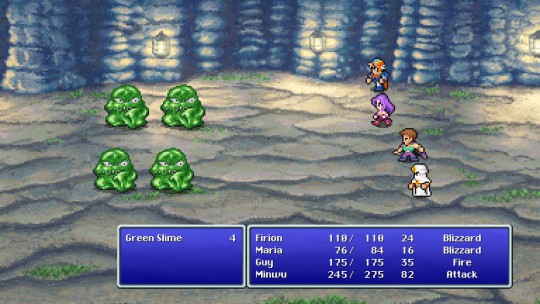
The original Final Fantasy was released in 1990 in North America and found some success, so work had begun to go into Final Fantasy II – there are English prototype roms out there to prove it. However, note that release date: 1990. The Super Nintendo would release in North America in 1991. In Japan, Final Fantasy IV was set for release in that very year. So what makes more sense logically? Release Final Fantasy II in 1991 – at the earliest – on a rapidly aging system that nobody plays anymore or skip it and release Final Fantasy IV instead?
Final Fantasy II was skipped, relegating it to the same fate that Mario Lost Levels would have. Since the Internet was in its infancy, most people playing Final Fantasy II on the Super Nintendo weren’t aware that they were actually playing Final Fantasy IV. Square would not correct the Final Fantasy numbering internationally until Final Fantasy VII and by the time VII came out, respectfully, very few people cared about the three titles they were missing out on. Final Fantasy II would not receive an official release in North America until 2003. Ironically, on the Playstation 1, which was in itself a rapidly aging system that nobody played anymore. But hey. It was here!
So was it like Mario 2 in that it was skipped over for a reason in that it was kinda middling and samey? Was it like Zelda in that it was too different for most? Was it like Castlevania in that it was hard to figure out without some guidance?
All is not as it seems
On a surface level, Final Fantasy II looks very similar to the original game. In the NES version, most character sprites look like recolored versions of sprites that showed up in the original. The main character, Firion, looks just like the fighter with some extra work done. Another character, Guy, looks like the sprite edit of the Thief. It looks visually uninspired and some might even think it’s a touch up of the original release. The combat is also very similar feeling. It’s still a turn based system and it largely relies on using physical attacks or magic.
That’s on a surface level though. When actually playing the game, the player realizes that Final Fantasy II is actually a fair bit different than the original and that realization starts immediately. When the player creates their party, they are no longer making four blank slate characters with no personality traits or dialogue. Instead, they get four characters with canon names who have dialogue. The original game was definitely an adventure with story as set dressing whereas this game eyed offering more of a story to go along with that grinding.
The story isn’t going to win any awards – this was a Famicom/NES game after all – but things are more fleshed out. The player’s main party joins a resistance movement, highlighted by Princess Hilda of Fynn (currently on exile in Altair) and Prince Gordon of Kashuan, to fight against the evil Palamecian Empire that is using demons and technology in order to conquer the world. Every town the player goes to has unique NPCs with unique Empire-related problems. The character section in the last article was relatively short but in this game, it felt like every location had someone new and interesting thrown into the mix. Characters have more to say and they give the player more motivation to go from one location to the next.
Adding to this expanded story is something called the key terms system. You can learn specific terms from NPCs and then ask other NPCs about them, which can change their dialogue and give you more story or direction. This small little step makes the storytelling feel a lot more immersive than in the original game. The player’s conversations with these NPCs that spout like three lines of dialogue total feel more like actual conversations because they are answering questions for the player. It feels interactive! The player doesn’t get key items and have NPCs just psychically know that they have the item, the player has to present it to them specifically. This system would never come back but it does a really impressive job of making Final Fantasy II feel like it has some sort of grand narrative.
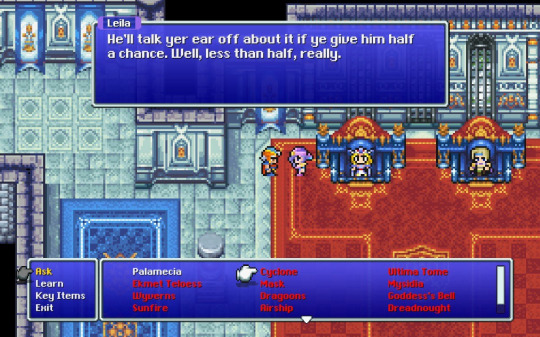
Having an actual cast of characters is really nice for those of us who started with later, story heavy Final Fantasy titles. Yes, you can role play as your thief in Final Fantasy I, but at the end of the day “GP or HP?” is a character that lives exclusively on your game cart or save file. When you talk to someone on the playground, they won’t know what the hell you’re talking about. With II, if you want to talk about the main character, everybody has the same one. Firion. Or maybe “Nathan” if you’re one of those weirdos who names RPG characters after your real friends.
I definitely named Aerith and Tifa after a crush or two in my day, no judgement here.
Oh! Aerith! That reminds me…on top of having more narrative, the game takes on a decisively darker tone than the original Final Fantasy. Yeah, chaos and Garland are no good assholes trying to take over the world. But do they actually kill anyone? Thinking as hard as I can, I can’t think of a single character or NPC that gets killed by the bad guys. In fact, every single death in the game can be attributed to the Warriors of Light. Murderous jerks. In 2? Well…
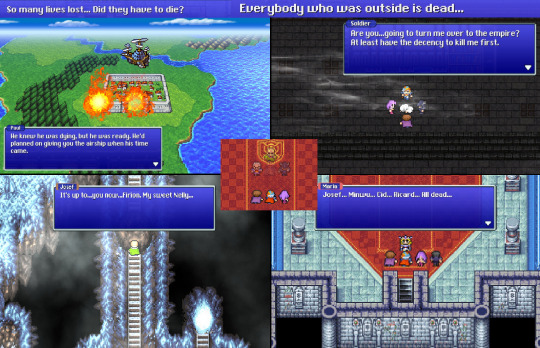
You thought Aerith was the first character to die in Final Fantasy history? No. If you meet anyone remotely important, there is a good chance they bite the bullet at some point. There are literal bombings on cities that take place in this game. Death is all over the place. It reminds me of when people are talking about what will happen at the end of a popular show – it always involves the question of ‘whether X character will die.’ I remember so much speculation about the potential death of Don Draper at the end of Mad Men. Death isn’t the only way to make something tragic! Still, Final Fantasy II kills off roughly a billion characters. I suppose it’s nice that the bad guys actually kill more people than the main party this time around.
The nitty gritty
For as different as this game feels from a narrative standpoint, it feels even more different when you’re actually grappling with the ‘core’ gameplay. I described the original Final Fantasy as a game designed with grinding in mind. Final Fantasy II takes this idea and supercharges it. There are no longer traditional levels. Instead, every single skill your character has needs to be leveled in some way. If your character wants to get better at evasion, you better make sure you have a shield. Got a fancy new sword? Better go out and do some random battles so your character can actually wield it properly. Have you ever played Morrowind? You know how when you start the game your character moves at like two miles per hour and if you want to get quicker you gotta, well, keep moving? This is a lot like that.
The goal of this is to create an immersive experience. If the player wants Maria to play like a white mage, simply teach her the proper skills, give her the right gear and her stats will progress in that way. If the player wants Firion to just be the warrior from FF1 simply jam on that attack button baby and they’re like halfway there.
I looked around to find if there were Western games released around this time frame that incorporated these mechanics. Leveling up every single thing is not terribly uncommon in CRPGs, for instance. But I could find nothing. So I’m not comfortable with saying that Final Fantasy II was the first video game to do something like this, but I will say it feels like Akitoshi Kawazu – the designer most people credit for Final Fantasy II being the way it is – got into a time machine and grabbed a bunch of mechanics from the 90s and tossed them into a blender for a console game released in 1988. Seriously, it feels nuts that an NES/Famicom game from the 80s would have this kind of stuff in it. I would love to ask someone like Todd Howard if they drew inspiration from Final Fantasy II of all things.
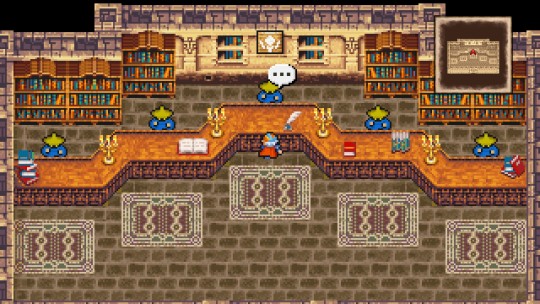
The way I approached the Pixel Remaster version of II was me just playing the game naturally. I had tried playing Final Fantasy II in the past and read about how cruel the leveling system is and just kind of fell off. The consensus best way to level stats for your characters was to wail on each other over and over again until you felt you were strong enough to continue. If you wanted to have your HP increase, you had to perpetually walk around with your HP very low. You needed to cast fire on yourself over and over and over again until it leveled up. Trying to play this way was an immediate turn off, so my suggestion to those playing FFII for the first time is to simply move forward. Don’t worry about over grinding spells and weapons until you HAVE to worry about it.
It’s still a bit of a cruel system because no matter what spell the player is casting, it needs to be worked on. For instance, this game has Esuna. In Final Fantasy X when Yuna casts Esuna, it cures all status ailments as soon as she learns it. In Final Fantasy II, when Firion learns Esuna, the only status ailments it can cure are Poison and Darkness. The player has to keep leveling it up to cure Amnesia, Toad and Stone. On top of that, you also have Basuna in this game. Esuna cures status ailments that persist after battle while Basuna cures status ailments that fade after battle. So if a character gets confused, the player needs to cast Basuna on him. Esuna does nothing. Of course, the player needs to level Basuna up to level 6 in order to cure confuse and the later FF mechanic of just smacking the shit out of a confused party member doesn’t work. So there is a need to grind both Esuna and Basuna if the player wants to effectively deal with status ailments. And you know what that entails? Casting Esuna and Basuna over and over again to no effect in battle. It gets tedious.
This game is grindy. It felt grindy even in the Pixel Remaster and as I noted in FF1, that version took a lot of the grind out of the original. My strategy when going from one dungeon to the next was to just cast spells on repeat in order to level them up. This did not cover all my skills though, at some point I had to pick and choose. So by the end of the game I was using Flare, Holy and Ultima pretty much exclusively as my damage dealing magic. The only buff skill I really bothered with was haste because it was really useful in the original but found it pretty lacking here. So my trips in dungeons consisted of me using the same spells over and over, running out of MP (the D&D-esque charge system is gone) and then attacking over and over. It felt dull and repetitive here, so I can only imagine how an NES player in 2024 would feel.
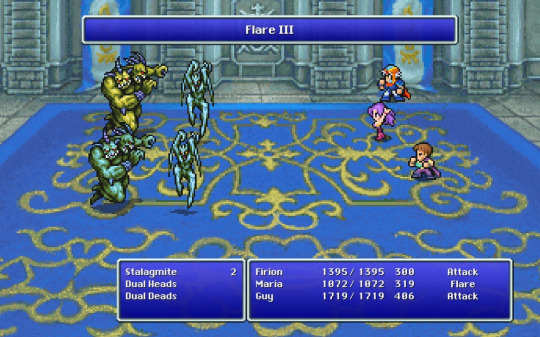
Jackassery
Speaking of dungeons, they are much more lengthy and involved here. I found that basically every one had multiple floors with lots of twists and turns. Even though I feel like my MP wasn’t lacking, I had to cut off my magic grinding less than halfway through most dungeons because I suddenly wouldn’t have the ability to heal myself. I feel like needing to grind every little aspect of your character is a poor combination with the resource management required of early Final Fantasy. This approach encourages the player to grind away from their main objective and as a result, the journey through dungeons feels unexciting because to conserve resources, they mostly running away or just jamming on the attack button. These dungeons are far lengthier than what showed up in FF1, you don’t want to run out of magic halfway through.
Also. This game is an asshole. Observe.
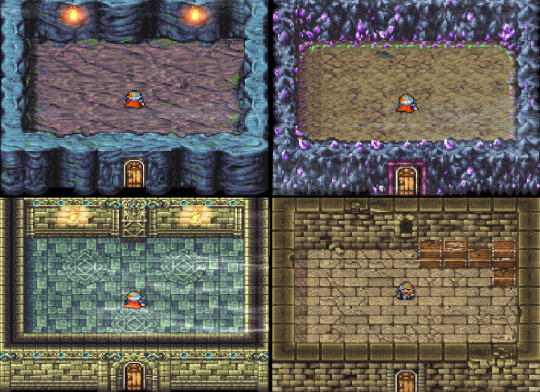
This exceptionally boring looking screenshot compilation is of four empty rooms. Your eyes do not deceive you, they are entirely empty. Nothing. What if I told you every single fucking dungeon is full of these empty rooms? They’re just there for seemingly no reason. If you’re like me, you try to get every single treasure chest that you can. You need those stinkin’ potions! So naturally you go from room to room trying to find all these chests and you get met over and over again with empty rooms. If there are five rooms on a floor, odds are that four of them will be empty. Sometimes more. But I’m gonna check every time because what if the fifth door has something? This actively punishes the player for exploration and encourages them to stick to the main path. If the player goes to every side room, they’re probably gonna get into more random battles, which will further drain their resources. It feels like you are being punished for trying to engage with the game.
Going back to Kawazu’s wacky time machine, I want to discuss another open world WRPG mechanic. Sometimes a game will gatekeep the player from certain areas by placing exceptionally hard enemies in their path. If someone were to run straight for New Vegas at the beginning of Fallout New Vegas, they are probably going to run into Cazadors and Deathclaws, the hardest enemies that game has to offer. It’s a subtle way of telling the player to fuck off. An unsubtle way of this is seen in basically any Pokemon game, where the roadblock can range from “some guy is thirsty” to “a bunch of people are hanging out here for some reason.”
At the beginning of Final Fantasy II, I was mashing monsters left and right. Nothing felt out of the ordinary. However, I went one pixel too far to the left and I encountered this.

I screencapped this because I was excited to see a bomb already. Hell yeah dude, a famous Final Fantasy enemy! What this screencap doesn’t show you is that these bombs self destructed for around 300 or so damage, well beyond what my characters have here. It should be noted that Bombs show up in the final dungeon too. Granted, by then they are pretty weak and easy to manage, but they are legitimately a final dungeon enemy. By going like a pixel off the main path I got destroyed. Some players find these early hard encounters useful for grinding spells since harder enemies equals better stat gains, but since I was trying to do a straight up playthrough without looking for too much guidance, this just served to annoy me. It ensured that I would basically not move a fraction off of the main path. Plus, in a game without autosaves, a random encounter that blows you out can make you lose hours of progress and it just isn’t fun.
There are also things the game doesn’t flat out tell you. Characters can wear any kind of equipment and equip any sort of weapon they want, which is good. But, unless I missed it, they don’t mention that wearing certain equipment has penalties. Heavy armors, shields and certain weapons cut your magic expertise by as much as 70%. The game doesn’t say that your mages actually need to dress like mages if they want to be successful (and if it does, I missed it), so you might just think your characters all suck ass at magic and never bother with it. And then, if you want to level up your defense or your evasion, you need those things, so if you’re aware of this mechanic you might feel the need to have grinding equipment and fighting equipment. Neat for MMOs. Extremely, extremely tedious for single player games.
Did you know that you basically go through the entire game with three characters? Now you might be looking at screenshots and notice that there are four characters in each one, but Final Fantasy II uses a rotating fourth cast member. This character changes all the time and after the first one, they kind of are all useless. Why? Because you haven’t grinded all of their abilities, stats and magic. You quickly get the impression that these characters leave you, so why would you waste time and effort making these characters as powerful as the main cast when they are just going to go away in an hour? You get a permanent fourth at the very end of the game and by then, do you really want to build this guy up so he can cast flare as well as the rest of your party can? As I said, this game is an asshole.
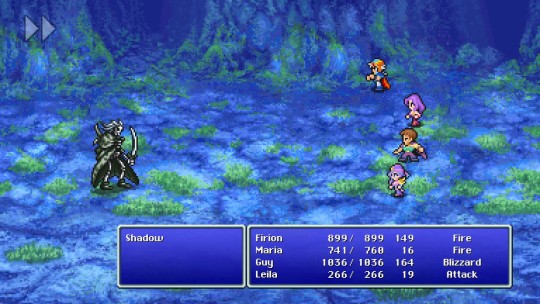
The trimmings
I want to briefly touch on music here. In my Final Fantasy I writeup, I wasn’t terribly kind to the music. I said the Pixel Remaster tracks felt like they came off of an assembly line. So using the magical power of 2024 technology, I modded in the original soundtrack into the Pixel Remaster and I gotta say it’s fantastic. The songs are all very catchy and they feel like they were composed with the NES’s sound chip and limitations in mind. I found myself humming tunes when not playing the game far, far more than I did with FF1’s remastered soundtrack. When playing these games, I think it is absolutely essential to put on Uematsu’s original soundtrack. It’s just fantastic. Sometimes just sticking with the original thing is the way to go and prettying it up for, well, whatever reason, is just unnecessary. I’m not a music guy so you’ll have to excuse me for the shallow analysis.
Final Fantasy II is an ambitious title. It sets out to do so much more than what Final Fantasy I accomplished. It takes the ideas of Final Fantasy I and expounds on them in many ways. I admire it for setting the series tradition of reinventing themselves for each new title. Without Final Fantasy II being a strange mess, you don’t have the weird game about a bunch of orphans with amnesia as the follow up to the game about a bunch of revolutionaries fighting against an evil corporation. I think it had a lot of interesting ideas, but ultimately feels too mean to truly recommend to anybody. I would say if you want to understand the Final Fantasy franchise as a whole, it’s important that you play and try to complete this game. The amount of things here that would go on to be staples in video games as a whole is really impressive, but if you’re looking for an actual solid game that you’re going to want to play over and over again? You should look elsewhere.
The cast
Unlike with Final Fantasy I, you have quite the collection of characters here. Just like with that game, I decided to compare character sprites between the Pixel Remaster and the original.
Firion

The main character of the game. As you will notice here, he borrows the Warrior sprite from the original Final Fantasy (NES). In the remaster, he gets altered to look more like the official artwork for the character. I was against drastic alterations to character sprites in the original Pixel Remaster, but I feel like since the original Final Fantasy II looks so similar to Final Fantasy I, changing things up is acceptable. These are actual characters now, so making Firion’s sprite just the generic fighter sprite feels unfair to him.
This is still an early JRPG, so Firion still doesn’t have a lot to his character. If I were to sum it up best, just think of generic main character dialogue and you have most of what he says. It’s nothing impressive, but it’s a start. They do have one thing with his character I really like though. There’s a scene where there is an imposter masquerading around as Princess Hilda. In this scene, she tries to seduce Firion – it gets so far that the rest of the party just leave the room because I guess they wanna let Firion get his freak on. And it even seems like it’s going to happen! This is like 30-something years before Clive and Jill laid naked on the beach in Final Fantasy XVI.

Of course, this is a fake. But it’s a neat little touch to his character. Yeah, he gets all horned up too! I just thought it was hilarious that the party, including Maria who I am pretty sure is supposed to be Firion’s love interest, are just cool with him randomly going to town on the princess during a pretty tense time in their world.
The way I used Firion here was pretty disjointed. At first I tried to make him a magic and sword wielder. I tried to make sure fire, blizzard and thunder were always fairly highly leveled but – since I wasn’t willing to take my armor off during big fights – I decided it was ultimately useless to focus so hard on that. In the end, he became a fairly dedicated warrior and when equipped with the blood sword, he made absolute short work of the final boss of the game. It was actually such an easy victory that I thought maybe I was playing something other than Final Fantasy II. I’ll take it!
Maria

I really like how close the Pixel Remaster keeps Maria’s character portrait to the original. It basically looks the same but less pale. To me, her NES sprite looks like a female warrior. I am pretty sure it’s also a reuse of an FF1 sprite since I think this is how Princess Sarah looks in the 8-bit Theater comics, but I don’t know for sure so I’ll give them the benefit of the doubt. Her new sprite matches her hair color instead of the weird red->purple thing the NES has going on so I like that.
Maria’s actual character is…uhm…I have no idea actually. I feel like she maybe says three words for most of the game. Then you meet her brother who has been acting as the dark knight for the empire the entire game and her character becomes ‘brother of the former bad guy.’ She’s there. But this is your first canon female party member – the white mage in FF1’s gender is ambiguous – so I guess take what you can get?
So when I play games like this, I like to have my lady characters be magic users. Like everyone else in the world. So Maria was pretty much doomed to be my magic flunky throughout the game. Until I got Ultima, her main usage in combat was to be the party healer. I made sure Cure, Esuna and Basuna were all as leveled as I could make them and generally speaking I never ran into too much trouble. I think I ran into two game overs the entire way? Not bad. As a result of this, I will name her MVP of my party.
Guy

Another case where I think the Pixel Remaster does a great job of capturing what the original portrait is going for. I am curious to see how the remasters handle IV-VI considering those are SNES games. Just like with Firion, his Remaster sprite is made to look more like his official artwork which I think is a good call because his original sprite is just a recolor OC Do not steal of the Thief.
Guy’s personality is very simplistic. Apparently his official backstory is that he was raised by wolves. I don’t remember this being brought up in the game, but the first couple of times I saw him speak I thought maybe the font pack I installed with my game altered and fucked up the translation. No…he just talks like a caveman because he’s something of a wild man. Think a more useful version of Gau from Final Fantasy VI, but with none of the bad guy copying skills.
In my playthrough, Guy was an axe wielding mad man who I tried to make proficient in magic but ultimately found it not worth the effort. I didn’t keep it up as long as I did with Firion, but I did at least try to make him a viable Holy and Flare user. I failed, mind you, because with my armor all equipped he was only doing like 100 damage with level IX holy but an effort was made. Perhaps I need to get good. During the endgame, Guy took on some healing duties since I had Maria focused on casting Ultima. But I can’t say he was too great at it. Kind of a jack of all trade and a master of none. Like the red mage!
Oh and he can talk to beavers. He’s the best character in the game.

Guy indeed speak beaver.
Leon

Another warrior edit for this guy, but I kinda like that decision because it gives him and Firion a bit of a Dante and Virgil from Devil May Cry thing. Speaking of Virgil, I feel like his NES portrait looks a bit like what an NES portrait of Virgil would look like. The remaster went with black hair because I guess that’s what his character art looks like. Okay. Probably the one character where I prefer the original.
Despite being the fourth main character on the character naming screen, you don’t actually get Leon until the very end of the game. This is because Leon spends almost the entirety of the game acting as the evil Emperor’s right hand man and generally being an evil asshole. Eventually Leon turns against the emperor and joins the good guys, but it’s not like he ever gets a true character arc. I’d say he’s like a really dumbed down version of Shadow the Hedgehog. No I will not elaborate.
Since Leon is the dreaded ‘fourth’ party member that I mentioned above, he didn’t do much for me at all. I think I just had him attack blindly during the final dungeon. I did teach him flare and a couple of other odd magics but he never really needed to use them because Firion with his blood sword and Maria with ultima were just dominating everything. He got to be part of the final party that saved the world but didn’t contribute very much. What a jerk!
Minwu

I love Minwu’s NES sprite so much. It looks like a character from Mario 2 (U.S.). I think they did a good job of recapturing the feel of it for the Pixel Remaster but damn. The original rules. I also don’t know why they decided to mask him up for the Pixel Remaster when he is maskless in the original. You’re a handsome dude Minwu, no need to hide that face away!
His character trait seems to be reliability. The Joe Kido of Final Fantasy II. He is Princess Hilda’s trusted white mage advisor person and is tasked with joining the crew to go get some mythril so the resistance forces can make some cool weapons to fight the emperor. He leaves the party so he can focus on healing up the King of Fynn. He comes back at some point to help the party acquire ultima and ultimately sacrifices himself to save the group. One of many deaths. But Minwu was an exceptionally useful party member so I was sad to see him go.
He is the first ‘fourth’ party member of the game and honestly he sets unrealistic expectations for the rest of the fourth members. He comes equipped with a bunch of leveled up white magic skills. I mean, just look at this shit

I think my other characters had like 20 MP and level 2 spells max at this point. I liken him to someone like Frederick from Fire Emblem Awakening. A character you get early to make things seem easier. Fredrick becomes useless later because other characters catch up and surpass him whereas Minwu becomes useless later because he leaves the party and fucking dies.
Josef
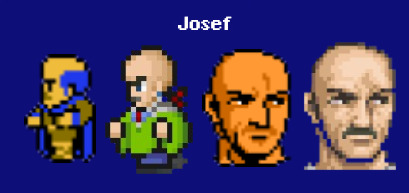
I love Josef’s sprites. The first one just looks like an old businessman LARPing as an elf. The Pixel Remaster one gives him a gigantic forehead because he does all of his exercising at the library.
Josef is a bit cold towards the party when you first meet him but he eventually becomes a big ol softie when Firion and crew save his daughter from slavers. His main purpose in the game is to give the party a snowcraft in order to transgress an impassable snowfield in order to obtain an item called the Goddess’s bell. He joins you briefly and is probably the most useless of the ‘fourth’ party members. He doesn’t come with any magic and while he fills the monk role you’d see a lot of later – he fights with his fists you see – I don’t think he ever did very much damage. Like Minwu, he dies saving the party. His death involves saving you from a giant boulder!
Leila

Looks just like a recolor of Maria, so automatically I prefer the remaster’s sprite. I think they did a really good job of making it match with her new portrait. I don’t think I like her having purple hair instead of red hair – especially since we already have one purple haired lady in the crew – but that’s a nitpick.
Leila is a pirate and hooks the party up with a boat, which allows them access to most of the world. There are really only a couple of places that you can’t reach by boat so it’s probably the most useful boat in the franchise? I guess we’ll see. She starts off mean, remember pirate, but joins the party as another relatively useless fourth party member. Unlike Minwu and Gordon she doesn’t die, though I was concerned when she got separated from the party in the Leviathan dungeon, and ends up being a big part of the resistance against the empire. She doesn’t have much of a personality but the pirate lingo makes her stand out so I always liked when she would show up. At the end of the game she suggests Firion becomes a pirate with her, which apparently upsets Maria. Firion is a lady’s man!
Gordon
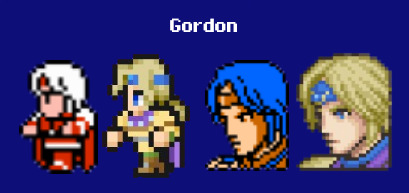
Damn, I love Gordon’s NES sprite. The white hair looks cool on him. I don’t understand why the NES portrait looks like Marth but, you know, that was the style at the time.
Gordon is the prince of Kashuan and has probably the only thing resembling a character arc in this game. He starts the game being a depressed coward because he feels like he let his brother, Scott, die. Eventually he decides to prove himself and in doing so helps the party defeat a giant airship that had been bombing all of society. The king of Fynn even acknowledges him and gives him a prominent position in the rebellion’s forces. He later agrees to partner up with Hilda, the princess of Fynn, in order to build up their kingdoms from the depths the empire has plunged them to. It’s not exactly the most compelling character arc, but it’s something! Oh and he’s another useless fourth party member. I got nothin’ on his gameplay because I legitimately don’t remember it.
In some versions of Final Fantasy II, Scott is a playable character. I generally feel like the bonus dungeons added to some Final Fantasy ports really suck and are rarely worth doing, but hey, he’s there if you want him. Since this remaster is supposed to be relatively faithful he was not a playable character here. It’s okay Scott, you were engaged to Princess Hilda before the game started, you won in some small way right?
Ricard

God damn look how cool Ricard’s NES sprite is. And he’s a good guy! This guy would have been a mega hit over here if it hadn’t released 15 years later. Since he’s kind of a dark character, I definitely agree with the decision to make him look kinda edgy in the Pixel Remaster. I don’t like his portrait as much though. Hide that mouth fella.
Ricard plays the role of the last dragoon in the world. That’s right, the extremely popular and beloved dragoon class debuts here. Want a character to be a megahit? Give them a spear and make them friendly with wyverns, odds are they will be one of the most popular characters in your game. Your party meets Ricard in Leviathan’s guts and he basically just exists to save the party from the emperor. He sacrifices himself so your party can regroup and challenge the emperor another day. Three of the five ‘fourth’ characters die. Not good odds!
In combat, Ricard had a pretty damn solid attack stat because he was putting up numbers comparable to Firion while he was in my party. He is probably the most useful fourth since Minwu, but he isn’t around long enough to make much of an impact. He also has no magic but he was hitting so hard that I didn’t mind it for once.
Princess Hilda
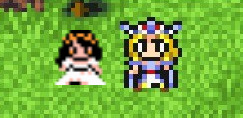
Princess Hilda is the second princess in the Final Fantasy universe and immediately she is a lot more memorable than Princess Sarah. Why does Sarah get used so much more in other media? It’s not fair! Her deal is that her kingdom, Fynn, has been overtaken by the empire so she is working with rebellion forces to take it back through their hideout in Altair, the game’s first town. She ends up giving the crew a lot of their tasks, starting with FIND MYTHRIL and evolving to STORM FYN AND TAKE BACK THE CASTLE. She was engaged to Gordon’s brother Scott at some point, but he died and I believe the game suggests her and Gordon are going to pair off now in order to help recover the world. Neat.
I decided not to make a separate character entry for the King of Fynn because he spends the entirety of the game either sick in a bed or dead. He’s not much of a character, so I consider Hilda the true face of the kingdom.
Cid
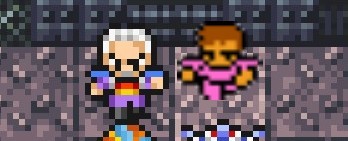
I like how NES Cid looks like Dan Hibiki of Street Fighter fame.
This is the official debut of the eternal Cid character. For those of you that don’t know, every Final Fantasy title has a character named Cid in it. Their importance varies from title to title. In some Final Fantasy games he is an important NPC, in some he is a playable character and in others he is an old mechanic that lets you perv on his mechanic daughter. He is typically an engineer of some sort or has a fondness for airships.
In Final Fantasy II he falls into the NPC line of Cids. His main purpose is to provide air travel to the party – at first he has an attendant that will charge you to fly to various world map locations but eventually you get his airship because he dies. A net gain, dare I say?
Paul
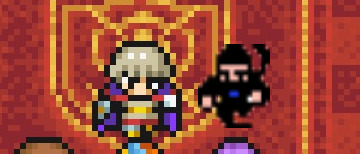
Paul is a thief character that is part of the resistance. He owes the party a debt because they saved him from a bunch of slavers in the game’s first dungeon, Semitt Falls. To repay this debt, Paul busts the crew out of prison, gives information about how to open up a secret passage at Fynn castle and even gives you a blood sword – well the location to it anyway – if you talk to him at the right time. The blood sword makes the end of the game a complete cakewalk so I really like Paul! The NES version of him appears to play up on his status as a thief by making him a ninja while the remaster goes more with updated renditions of his appearance. I prefer ninja Paul, he doesn’t have a bowl cut.
My favorite sprite, Ogre Mage

Just like with Final Fantasy 1, I just wanted to highlight a random enemy sprite I really like. This time it’s a very early enemy called the Ogre Mage who…yeah, I bet you can guess everything about him by his name. I really like the shadows over his eyes, it makes him look really demented. He reminds me of Sloth from Full Metal Alchemist.
Forces of the Palamecian Empire
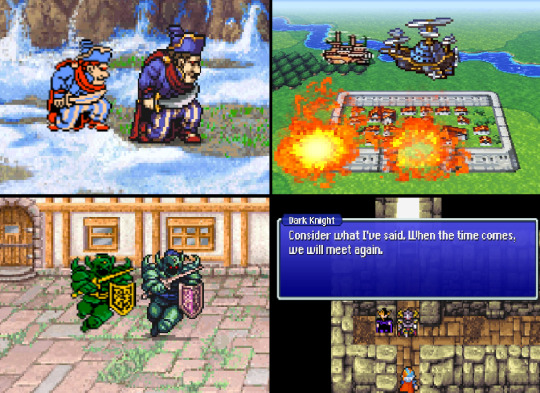
The main badguys of the game! The connection between all of the villains is made a lot more obvious here because they are all part of the same empire, there isn’t some 2000 year relationship going on! So let me break down these four screenshots real quick.
Upper Left: Borghen. He’s a sniveling coward who betrays the kingdom of Kasuan because he sees the tides turning and wants to join the winning team. He’s portrayed as incompetent, though he does manage to kidnap Josef’s daughter Nelly at some point. The party runs into him while trying to find an item called the Goddess’s Bell and the boss fight is great because it’s one of those times where the gameplay matches what the story tells you – this guy is a joke. But upon death he triggers a boulder that kills Josef because even this joke character has to get a confirmed kill. I like to think this guy laid the ground for characters like Solt and Peppor from Chrono Cross or Zorn and Thorn from Final Fantasy IX.
Upper Right: The Dreadnought. The first portion of the game involves the rebellion trying to destroy this thing. It is a warship of immense power and is probably the most devastating weapon that the empire has available to them. You destroy it by trekking through it like a dungeon and tossing some sunfire into the engine. I found this to be one of the game’s more intimidating dungeons because I ran out of MP about halfway through, I had no ethers and I couldn’t exit to go heal up. I was very grateful there wasn’t a big boss at the end of the dang thing. I was pretty surprised when an early game cutscene shows this giant ship just flat-out bombing cities. Impressively, it even changed the look of the city. I’m not sure if this happened in the NES version or not, so if this is a Pixel Remaster exclusive…nice touch!
Lower Left: Captain. The Captain is not a major character, but I thought he would be a good choice when talking about the grunts of the empire. When the party goes to Fynn, something strange happens that doesn’t happen in any other town in this game. Random battles! This is an excellent little bit of gameplay serving the story because Fynn is overrun by the empire so it makes sense that this town is swarming with baddies. The Captain comes in as an elite unit the party has no chance of beating the first time they arrive into town. You are told to stay away from them – they aren’t random battles, they are NPCs – because you don’t want to raise alarms that the resistance is moving around. It would be wise to listen to the warnings because the Captain one shot every member of my party with ease. When you actually liberate Fynn later in the game, it feels like some nice progression being able to explore the town without fear of a Captain wrecking you.
Lower right: The Dark Knight: Final Fantasy titles love their brooding dark knights. The Dark Knight here is the right hand man of the emperor for most of the game and later tries to ascend to the throne when he believe the emperor has been killed. It turns out that this character is Leon, the party’s fourth member that they were separated from at the beginning of the game. The game never says why Leon turns to evil but I appreciate that they never excuse away his actions by saying he was brain washed or he couldn’t help it. When he joins the party, he never acts overly friendly towards them either. He’s just there because a bigger threat arrives. I think he’s probably the most interesting villain in the game just because what drives him is mostly a mystery.
The Emperor

Apparently this guy is also known as Emperor Mateus, but I never saw that in the game so I’ll stick with just calling him “The Emperor.” If you close your eyes and think of the most generic evil dude ever, well, you got him. He wants to destroy the world and will use magic and technology to achieve those goals. In your initial battle with him, he is portrayed as something of a coward because he summons a bunch of guards to help him out. He’s a bit of a pushover here. The game goes to a lot of lengths to convince you that he’s dead and that the Dark Knight is now the true main enemy. They even celebrate his death with a fun dance at the castle in Fynn!\
He’s not done though. He comes back from the dead by conquering hell or something – the specifics of it are vague but he says that he gained powers in hell and will topple your forces and presumably the world. This is when the Dark Knight decides to become Leon again and help the party save the world from the obviously bigger threat. I think the Remaster does a good job with his overworld sprite because he looks far more intimidating and boss-like upon his return.
The Emperor serves as the final boss of the game and compared to Chaos he’s a bit of a joke. If you remember with Chaos, I had went beyond the level cap of the original Final Fantasy and was still struggling to defeat him – it was an absurdly challenging battle that represented a large step up in difficulty from the rest of the game. The Emperor on the other hand is stupidly easy, as long as you have the blood sword. Firion was causing like 7,000 damage per hit with his sword and Maria was causing over a thousand with Ultima. Maria also still had normal armor equipped so if I had died, I would have stripped her down and assumedly hit far harder. He’s probably a fair deal more difficult without the blood sword, but if the game is going to give me an easy way to deal with the final boss, why wouldn’t I do that?
It started here
Here is a look at some franchise staples that got their start with this game.
Cid, the word Highwind (Ricard’s last name), main character deaths, Final Fantasy ‘sequels’ having nothing to do with the previous entry
These are touched on above so I won’t go into much more detail about them. The Cid thing is fun because everybody knows about Cid and everyone has a favorite Cid. Me? I’m a basic bitch and my favorite Cid is Cid Highwind from Final Fantasy VII. The word Highwind also goes on to become a bit of a Final Fantasy staple. Fun fact, in the very first Kingdom Hearts game you have to run a race against Riku, the rival of the main character Sora, and the reward for winning is the ability to name your ship. In my first playthrough, I of course entered the name Highwind and was pleasantly surprised to see that Riku had also chosen that as the name for the ship. It felt extra good considering I don’t think I have ever won that race despite playing Kingdom Hearts 85,000,000 times in my life, so I never actually got to name the ship myself, but it still got the name I wanted. Why does Sora act so distressed over it? You got the name you wanted buddy!
The sequel thing is definitely the most important part here and is a key element of the franchise. I think III regresses things a little bit and is a bit more like the first game, but generally each new Final Fantasy reinvents itself in some way and feels a lot different than what came before it.
Chocobos
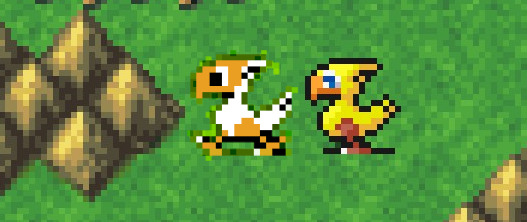
That’s right, we got our first mascot! The Chocobo Forest is south of Kashuan and is pretty well hidden, to the point that it almost feels like an easter egg for players familiar with the franchise. But no, it was always there and Final Fantasy II is just a mean game that doesn’t want to give you easy access to a ‘skip battle’ mechanic.
The chocobo functions much like it does in later games. You find one and ride it around the world map. You can’t enter towns with it, but while you are riding you move quicker and random encounters are disabled. In the console version of the remaster and modded PC versions you can just turn off random encounters if you want to, so the chocobo being here is even more of a ‘fun little easter egg’ for those players.
Sadly no chocobo inbreeding until Final Fantasy VII.
Unwinnable battles
A fine JRPG tradition like no other. Occasionally you will have fights that you can’t win no matter what you do and just exist to progress the story. The one I remember most vividly in my head is Beatrix from Final Fantasy IX. This game starts out with an unwinnable battle that separates Leon from your crew and gets your characters to join the resistance. I like these in the sense that it really helps show your party’s progression when you fight unbeatable enemies again and come out on top.
Familiar monsters

I feel like it’s a good thing to point out the first appearance of iconic enemies in the franchise. Here’s a little mashup of some familiar faces. The one that may not be as immediately obvious is the iron giant in the top right. He looks far more sinister than later incarnations of that baddie, I actually prefer this aesthetic. I think I like the NES version of the (King) Behemoth because it looks like it has a giant fin on its back. Ya gonna go swimming or something buddy?
MP (Magic Points)
Mentioned exceptionally briefly above, but Final Fantasy I used magic charges while this game introduces the MP system to the Final Fantasy franchise. Most games in the franchise use it from here on out, with the most prominent exceptions leaping to mind being Final Fantasy VIII (which replaces it with the junction system) and Final Fantasy XVI (which is an action game and has different mechanics all together). I think the charge system worked great for what Final Fantasy I was going for, but MP suits the franchise better as a whole.
Ultimate weapons for real this time, I swear
The Excalibur comes back! Again! But this time it’s overshadowed by the blood sword, which I am far more comfortable in calling an ultimate weapon than the Masamune or Excalibur from the original. The blood sword doesn’t work against every enemy in the game, its actual stats are lower than several other weapons, but it does work against every big enemy in the final dungeon which I think goes a long way into cementing its status as an ultimate weapon. There are several hard enemies that pop out in chests in the final dungeon and the blood sword makes short work of them and I’ve already mentioned how the final boss gets obliterated by it.
Dual wielding weapons
What would later go on to become the calling card of the ninja job, dual wielding starts here. Every character can dual wield every type of weapon, except those that require two hands to wield (bows). You can also dual wield shields if you want to. This is handy for grinding up weapon levels since you can do two types if you so choose to. For me, in more cinematic titles, when a character reveals they dual wield they instantly become way cooler. To mention Kingdom Hearts again, one of the things I remember the most about the original’s secret ending is when the mysterious cloaked figure (who would go on to become Roxas) pulled out his second keyblade. At that very moment I became obsessed with what the next Kingdom Hearts game would look like. I would like to think I have Final Fantasy II to thank in some small way for that.
In conclusion
Final Fantasy II is an ambitious but flawed game that can feel like it’s actively punishing the player for trying to get the most out of it. It feels like a game created with knowledge of future mechanics but without the knowledge of what makes them work or fun to engage with. I admire the heck out of it and cannot bring myself to hate it, I legitimately don’t understand people who plop it on ‘worst game ever made’ lists because it absolutely doesn’t belong there.
Just like with the original Final Fantasy, it’s a good idea to at least try the NES version before jumping into the Pixel Remaster. It’s nice to gain some perspective on what it originally looked and felt like. Unlike with the original Final Fantasy, I feel like you don’t lose out on a whole lot by sticking with this version of the game. Even with some quality of life and balance tweaking, the Pixel Remaster still feels like an ancient grindy NES game.
For most players, you only need to play a little bit. There is no need to beat the whole thing just to claim you’ve beaten every Final Fantasy. It’s worth sticking through to see all the innovation as it can help you appreciate what the title is going for, but don’t feel bad if you get annoyed and bounce off of it.

#Final Fantasy Retrospectives#Final Fantasy II#retro#retro gaming#video games#opinion#ps5#switch#pc#Final Fantasy
0 notes
Text
No Items. Fox Only. Final Destination: A Mario Superstar Baseball story
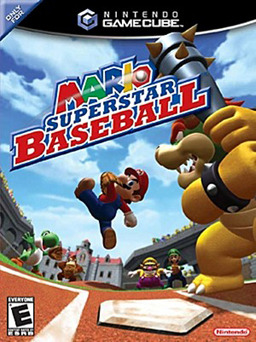
Nintendo multiplayer games love their gimmicks. It's a frustrating trend of theirs because often times the core mechanics of those games are really solid but if you play the way you're 'supposed to,' those gimmicks can really bog you down. Like imagine you're playing a game of basketball and all of a sudden some guy ran on the court and circled a tiny portion of the floor. It's the "instant win zone." If you sink a basket from the instant win zone the game is automatically over, regardless of the score. It sounds ludicrous but gimmicks in Nintendo games can be every bit as game changing.
The area where this is most well known is in the Smash Brothers franchise. Back in the day, there was a bit of a meme going around where people would be playing Smash Brothers with items on and someone would rush onto the scene and say "NO ITEMS. FOX ONLY. FINAL DESTINATION." This would mutate into some guy challenging people in random situations to this specific rule set. You see, no items and final destination (a flat stage) are the core elements of Smash Brothers. There are no gimmicks, there are no weird things interrupting the flow of play. It's a competition of skill. And Fox is there because, uh, he's the best character. Silly memers, don't you guys know Marth and Jigglypuff are really viable too?
For Smash Brothers, I've always been kind of hit or miss with this because I think the game is still fun with items on and it also allows for players of various skill levels to play together. It's the great equalizer. Yes, you will probably beat a scrub 99% of the time but it does open the door for miracle wins. There is another game where this ruleset changes the game though. Where trimming everything down to the basics takes a forgotten Gamecube title and turns it into one of the best pure party gaming experiences available.

Mario Superstar Baseball is a game with simplistic enough mechanics. Really, it feels like a prettier version of RBI Baseball. Swinging, stealing, diving to make sensational catches, they're all done with a single button press. You can even do super powered swings and pitches. Picture the most arcadey and simple sports game in your head and you have the basics of Mario Baseball. It's great with friends but if you decide to play by the official game rules, it just becomes a whole lot of nothing. The gimmicks bog everything down.
What I mean by this is that most of the levels are completely overrun with gimmicks. There are levels where invisible blocks clutter the air, which can get in the way of fly balls and create an out of a big hit. There are levels where klaptraps run around the outfield and bite at your fielders, which can create big hits out of easy outs. You have piranha plants and whomps randomly scattered around some fields to cause havoc too. Yes, these definitely make the game feel more "Mario" than a typical baseball game. But you know what else does that? The fact that I can select Mario characters as my baseball players and play as them. Revolutionary!
There is one exception to this. Mario Stadium. Mario Stadium has absolutely no gimmicks. It is the Final Destination of this game. If you want a pure experience without random chance ruining your day, this is the way to go. Unlike with Smash Brothers, the gimmicks here don't really bridge the gap between skill levels. Instead they just frustrate the player entirely and turn the event into a far more luck-based affair. Mario Stadium changes that and you can finally just play a basic arcadey baseball game. I think it's the best arcade-style baseball experience in video games, surpassing even the classics. It's just lost in the weeds of gimmicks.
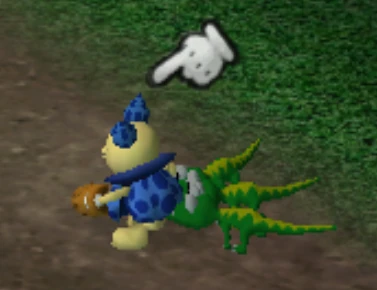
Now what about the FOX ONLY part of the above equation? There is one extra little rule that can take things a step over the edge. Round-robin picking. When you play two players, the selection process is a free-for-all. Whoever can move their joystick the fastest can get whatever character you want. This is a big deal because there are players very clearly better than others - the team captains, or the main Mario characters. It's not likely, but there is a chance one player could get every single named Mario character while player 2 gets their one team captain and then a bunch of shy guys, toads and maybe like King Boo. Round-robin selecting just lets each player choose their own team at their own pace and unless you're playing someone who can't understand basic UI elements, your teams come out pretty even. It's a truly equal playing field.
Playing like this allows the player to experience one other mechanic a little more readily. If you're flying through the character selection process, you're just going to pick who the best people are without thinking about it. Like "Oh fuck I need Mario and Wario and Luigi and Bowser and I just need these guys because I know they are good." But just like in real team sports, Mario Superstar Baseball has a mechanic called chemistry. Some players just don't play well with each other.
Having a team with good chemistry has a lot of benefits. For one, you have more 'star powers' at the start of the game - I mentioned those above, referring to them as super powered swings and pitches. Having star powers to unleash in crucial moments is really helpful and can help you score a lot of runs when you need them most. Also, played with good chemistry play better together. If your shortstop and first baseman like each other, the throw from short to home will be a little quicker than just a neutral pairing. So instead of just building around on who hits the best, you can consider building a team with a mix of skill and chemistry.

Now you might think "well okay, I don't need to worry about chemistry, who cares about slightly faster throws?" Wrong! There are punishments for bad chemistry too. Let's say you have a shy guy at shortstop and baby mario at second base and the batter just hit a ball that would be an easy double play. Shy Guy can grab the ball but there is a small chance that the throw to second base will be off. When characters have bad chemistry, your defensive plays (specifically throws) can go awry. You can turn an easy double play or out into a free hit. Well, an error really, but you get what I mean. Paying attention to who is playing where is a big key to success and just being able to pick freestyle clashes with said mechanic.
Combining a Mario Stadium rule with a round-robin choice system creates the definitive way to play an otherwise forgotten gem. It is the best version of the limited melee ruleset. It takes a solid party game and makes it great. Just don't play the Wii version please.
0 notes
Text
Final Fantasy and Accepting the Warts of Age
Note: This is the first of a planned series on the Final Fantasy franchise. I plan on posting these on my own website, vidyathoughts.com but for now I will also crosspost here. I hope you enjoy!
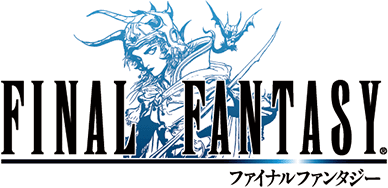
A mixture of reality and fantasy
The origins of Final Fantasy are pretty well known. Hironobu Sakaguchi wanted to make a role playing game but the genre was not a proven commodity in Japan. Then Dragon Quest came out and changed everything. Dragon Quest would go on to become such a phenomenon that according to a Game Informer interview with current series producer Yu Miyake, following the release of Dragon Quest 3, Japanese police requested that Enix not release new Dragon Quest titles on weekdays because too many kids were skipping school in order to buy the game. Even before 3, Dragon Quest proved that the role playing genre could be successful in Japan and Sakaguchi was given the go ahead to start making his own RPG. So a team of seven individuals went on to make the first title in what would go on to be one of the biggest franchises in the world.
The cute version of the FF origin story that gets repeated time and time again is that Square was a company on the verge of financial ruin and the title was named “Final Fantasy” because it was the company’s last shot at success. If Final Fantasy were to be a failure, it would indeed be the final fantasy title Square would ever produce because the company would be out of business. This tale has likely been embellished because, well, it’s cute. Who doesn’t like a Cinderella story?
“The name ‘Final Fantasy’ was a display of my feeling that if this didn’t sell, I was going to quit the games industry and go back to university. I’d have had to repeat a year, so I wouldn’t have had any friends – it really was a ‘final’ situation,” Sakaguchi said in an interview with MCV UK in 2007. But in an interview with Chris Kohler of Wired from 2009, series composer Nobuo Uematsu stated that: It’s true that Sakaguchi was going to quit, but the bigger reason, the real reason, was that Square was going to go bankrupt and the designers believed that it would be the company’s swan song.
And most recently, you have a keynote speech that Sakaguchi gave in 2015. Casey Baseel of Sora News translated what he had to say about the naming of the franchise like this: ”The team had already decided they wanted something that could be easily abbreviated using the Roman alphabet. They were also set on something that could be condensed into a four-syllable abbreviated version in Japanese, and FF (pronounced ‘efu efu’ in Japanese), fit both criteria. Given the genre the game fell into, making one of those Fs ‘fantasy’ was a no-brainer. But what about the other one? Actually, ‘Final’ wasn’t the team’s first choice – the initial idea was to call the game Fighting Fantasy. However, they had to nix that plan when they discovered there was already a board game called Fighting Fantasy, which was in turn based on a series of British gamebooks.”
Stuff of folktales. Would the fun origin story for Fighting Fantasy be like “Square realized they didn’t have a fighting chance unless this game succeeded. And it was a Fantasy title. So the title Fighting Fantasy was born.” I like to picture the warrior class as some sort of Paul Bunyon character with a chocobo as a blue ox. I think it’s fitting that a fantasy franchise has fantastical and exaggerated origins.

Personal failings
My first experience with the Final Fantasy franchise was with Final Fantasy VI (III in the U.S.) on the Super Nintendo. I was a poor kid who was coping with my lack of access to Final Fantasy VII by playing the next best thing my game rental store had. I tried to get into it but it was difficult because I knew the GREATEST GAME OF ALL TIME FOREVER was out there and I just couldn’t play it because I didn’t have a Playstation. Eventually though, I would get there and become a fan of it all. I loved moogles and I wanted more of them.
So like any person who discovers their new favorite franchise for the first time, I needed to experience every single game that it had to offer in some way. Even as a middle schooler, I was savvy with emulators. How else would I play Dragon Ball Z: Hyper Dimension? So instead of being a responsible member of society and purchasing the easily available Final Fantasy Origins on Playstation 1, I instead downloaded NESticle and a rom of Final Fantasy and…boy was it not for me. I saw the heights the franchise would get to and this just didn’t compare. Where were the fancy summons? The card games? The story?
I feel like this is probably a very common experience when trying to play the old Final Fantasy games. The franchise wasn’t always about delivering a game and a story, it was at one point just a game with a story as scenery dressing. I would go on to play Final Fantasy I on the NES as an adult and was able to see the beauty in it, but I will never forget running into a brick wall the first time I played the game.
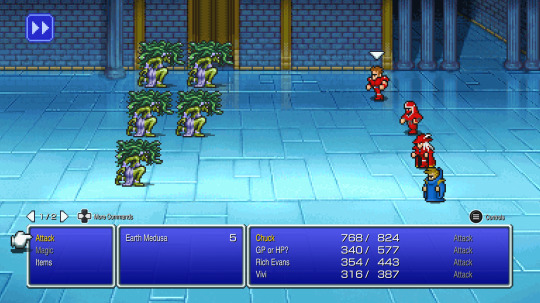
Actually playing the game
Final Fantasy I is a different experience from what I was used to. While it is turn based like those Playstation games, it feels like more of an adventure game than the later titles. The player will need to really explore the world they are in in order to find out where to go next. You have the basics of your journey: Everything is fucked and you need to restore the light of the four crystals in order to make things right. The four crystals are representative of the four elements (Earth, Air, Water and Fire) so your adventures will take you to those biomes far and wide across this massive – for the time – world.
The NPCs do give you hints about what to do next, but they don’t hit you over the head with it. There isn’t a line of dialogue that explicitly tells you that you need the rosetta stone from the sunken shrine in order to understand the people of Lufenia, which will then lead you to the tower of mirages, which will eventually get you into a fight with Tiamat. You have to talk to everyone and piece it together. You have to explore.
As you explore, you will be slammed with random encounters. Since you aren’t expected to know where to go on your first playthrough, a lot of your grinding might feel natural. Even still, when you first get to an area, you’re probably not gonna be able to waltz up to the boss and smack them down. In later Final Fantasies, I find that if you just don’t run away from fights, by the time you get to the boss of an area you will probably be well equipped enough to defeat them. This is not the case in Final Fantasy I. Grinding is a big part of the gameplay. The first time I played the original Final Fantasy, I waltzed over to the Chaos Shrine to fight Garland and got my ass handed to me because I didn’t spend enough time beating up goblins.
While a lot of people might look at grinding as cumbersome, I think it’s important to note that it was a big part of the gameplay. You weren’t playing for the story with this game, you were playing for the adventure and part of said adventure was fighting a lot of battles. It was also about keeping track of your inventory and using magic responsibly. Instead of magic points like later entries use, the original Final Fantasy uses magic charges. It’s a system much like you’d see in Dungeons & Dragons where you can only use your spells so many times until you rest to recharge them. Originally, there was no way to recover your magic outside of this. If you wasted all of your Fir3 (Firaga) charges on random enemies, that was it. You couldn’t use it again until you rested. Need it for a boss? Too bad. Go back and try again.

When your main gameplay loop involves fighting a lot of battles, your strength becomes more apparent as you play making progress feel really significant. Let’s say you just got done dealing with Mount Gulug and you head back to the first area of the game, Cornelia. When you get there, you’ll find that those goblins that you had to wail on in order to ensure Garland didn’t knock you down aren’t so bad anymore. Even your White Mage can probably one shot them! This isn’t an experience unique to this particular Final Fantasy, but when a lot of your random battles are won by the skin of your teeth it really does feel quite special here.
The battle system itself, primarily attributed to Akitoshi Kawazu (though I’ve also seen Hiroyuki Ito credited), is truly turn based. You can attack, use magic, use items or run. Barebones, but you can take as long as you want to select what you want your character to do, which might feel strange to series veterans more accustomed to the ATB system. I’ll get more into THAT system in the first game that uses it: Final Fantasy IV. The basics of FF1’s system would carry the first three games of the franchise, though some elements around the battle system get changed in those titles. In the first game, I would say the combat is fairly simplistic and the actual gameplay is more carried by things you do on the periphery like item conservation, but I think they expand things a bit in the next two games. This is a fine baseline.

Changing things up
As I’m sure you’ve noticed, the screenshots I am providing for this game come from the Pixel Remaster. In this version of the game, they make things a little easier for the player. Shops sell ethers, you generally don’t need to spend as much time grinding and there is an NPC in Cornelia that specifically exists to tell you where to go. The Pixel Remaster tries to take this ancient title that middle school me rammed his head into fruitlessly and make it accessible to more people. It is nice in the sense that it will allow more people to play the first Final Fantasy, but is that really the same experience?
When I first started the Pixel Remaster, the very first thing I did was walk over to the chaos shrine to fight Garland. My head was going back to my middle school days where I was mercilessly killed by what a lot of people consider a joke boss. I didn’t do any grinding and I stepped in and…I just won. And in like five hits to boot. Not feeling confident before a boss? Just quicksave. Gone was that need to grind, instead it felt like I was playing the game on fast forward. Just like with later Final Fantasy titles, I would go from location to location and if I just didn’t run away, by the time I reached the boss, I would be well equipped enough to win. Sure, some of the crystal guardians (the four fiends) were tough battles that would feature one party member getting killed, but most of the time these fights would be uneventful.
Looking around to see if I was misremembering my experience with Final Fantasy I, I found a reddit post that said the remaster was made for people with jobs or had better things to do. In a sense, I agree, this game does get to the point a lot quicker…but is that really Final Fantasy I?
I think in order to get the true experience with the original Final Fantasy, you need to toss up that emulator – or NES classic, or NES or whatever you have at your disposal – and throw yourself at hordes of enemies. As I said earlier, the original Final Fantasy is not a game you play through for the story. If FF1 had a narrative as engrossing as Chrono Trigger but was locked behind this really hard to approach (in a modern sense) video game, I would say it’s necessary to ‘dumb it down’ so people can experience it. I don’t know if I see it that way with the Pixel Remaster though. Sure, you can beat the game this way and that’s great for people that just want to play every single Final Fantasy game and get on with their lives, but I don’t think you’re getting the authentic experience. The tedium that comes with random battles, the rage you might feel after finishing a dungeon only to die on your way out of it and the grind is every bit as much of what Final Fantasy is as the four crystals are.

Now that’s not to say I think all of the changes are ‘experience ruining.’ I think most people consider video games of yesteryear to be a little obtuse in order to sell strategy guides. That’s a slightly cynical way to look at it, but how the hell else were you supposed to figure out Casltevania 2? Were you supposed to just blindly bomb every single wall in Legend of Zelda in order to find a path through the dungeon or were you supposed to find a copy of Nintendo Power to very helpfully point you in the right direction? So quality of life features that don’t actually alter gameplay, like the hint giving dancer NPC and the remake offering a wide variety of maps, are fine by me. You’d have to pay a premium to see these in a strategy guide in the past, so I don’t think having easy access to that content is game ruining. You can also just ignore it! You can’t ignore not needing to grind though.
I also think this specific remake of the original Final Fantasy does one thing way better than some past remakes. It retains the magic charge system. Your level 8 flare (nuke) spell can only be used so many times and its usage is independent of your other magic spells. This makes it so if you want to have an authentic experience where you have to strategize your magic usage in dungeons, you still can. Having all your magic tied to the same magic points system changes things too drastically and I think most players could not forsake quality of life items to experience something closer to the original.

And visually, while I prefer the charm of the older sprites, I love that this remake does its best to remake those and present them as something new. Here I have compiled the playable character sprites from the original and the Pixel Remaster. In case it isn’t obvious, the order goes NES, Remaster, NES, Remaster. You can tell the new ones are based off of the old ones, even if some of the changes are odd (I miss my fighter having red hair). I compare the way this looks to how the Super Mario All-Stars games look. Yeah, the sprites are redone but they are close enough to the original where it still feels authentic. Now, let’s take a look at the GBA remake sprites.

They just look completely different. There’s no ‘trying to retain the spirit’ of the original, your characters look completely different. Yeah, your thief looks more like a thief but it’s a different guy entirely! The class ups no longer look like ‘grown up’ versions of their original selves, they just look more advanced. Your black wizard no longer looks like Sabin, he looks like Vivi! I think a good remake that is trying to be faithful should try to embody the spirit of the original as much as possible and just changing things this much feels superfluous. So I’m glad Square Enix did something else for the Pixel Remasters. The best option would be to include the original game with all remastered versions of the game but that will likely never happen.
I’m only going to touch briefly on the music. I don’t think Final Fantasy I hits the heights of the later entries, but there are definitely some classics in there. The battle theme is iconic, for instance. I think the original versions of these songs are definitely the way to go. Something about the remixes the Pixel Remaster collection has just sounds too pure. They sound like something off of an RPG maker assembly line. Thankfully the console ports offer an option to stick with the original songs but for Steam players like myself…uh, well, I hope you know how to mod!
My experience through the early Final Fantasy titles for this series will be through the Pixel Remasters just because they are the most convenient ways to play them in 2023. But I have also played each of these games before. Maybe not to completion, but I know what they are supposed to feel like. But for people who just want to play every Final Fantasy game, I encourage you to at least try to play the original version instead of the Pixel Remasters. It just isn’t the same experience. If you’re a returning player though, nothing wrong with trying a different way to experience a classic.

Notable characters
I have wanted to write something like this about Final Fantasy games for quite a long time. I was inspired by articles written by a guy named Pat (Pitchfork) for the website Socks Make People Sexy. These were all done a long time ago though and I wanted to make something similar, but in my own voice and from my own perspective. One of my favorite things he would do in these articles is do a rundown of the cast. So I plan on doing that with my retrospectives as well. Final Fantasy I doesn’t have a ton of plot important characters, but let’s look at what we have. These impressions are based on my most recent playthrough of the game.
My party: The Warriors of Light
You need to pick four characters for your journey through this game and unlike (most) later entries, your characters have no personality. You have to name your crew, pick from the six classes and kind of imagine how their personalities would be.

Chuck the Warrior/Knight. So both my party composition and a couple of their names come directly from an old webcomic called 8-Bit theater. I feel like the most recognizable gag for the Warrior in those comics was ‘sword-chucks’ which is a genius invention that works exactly as it sounds.
In this playthrough, Chuck was an absolute beast. He took 1 damage from most enemies and almost never died. In fact, I think he never did keel over until the final battle with Chaos. He almost single handedly carried me through the entire way. I have never been one for challenge runs because I am a giant baby, but I would wager simply not having a Warrior would make things really hard for most people. Truthfully, I think a party of three Warriors and a Red or White Mage would probably be more effective than my diverse and fun party of rapscallions. Hey though, it’s early, they were still figuring out the job system!

GP or HP? the Thief/Ninja. The second of my 8-bit theater references. This line has stuck with my for the years and I don’t know why. So it felt natural to name my Thief that. Unfortunately the Pixel Remaster decided to rename GP to ‘gil’ as that is the series standard so now my little thief’s name makes less sense. Ah well.
Despite being named a thief, you can’t actually steal anything in the original Final Fantasy. So what differentiates him from the king of DPS the Warrior is his speed. The Thief can dodge a lot of things and as a result, he didn’t really die all that much either. He wasn’t quite as invulnerable as the Warrior – the fight with Marilith/Kary/the fiend of fire was basically a Warrior solo effort at the end – but he was a very effective secondary damage dealer. He received a brief promotion during the battle with chaos to be every bit as important as the Warrior though. I gave him the most powerful weapon in the game, the masamune, and when he was hasted he would sometimes out damage Chuck. Wow!

Rich Evans, the Red Mage/Red Wizard. I am stupid. So when thinking of a name for my Red Mage, the first thing I thought of was another thing with the word red in it: Red Letter Media. And then I was like, well, you’d have to be a real asshole to hate Red Mages. So I chose the one RLM guy I thought you’d have to be an asshole to hate. Rich Evans.
For people unaware, the Red Mage is a jack of all trades. They can cast white and black magic. A healer and a damage dealer! On top of that, they are handy with a sword so they can do just a bit of everything. Unfortunately, I found Rich Evans to not really be good at much of anything. Casting black magic as a red mage is pointless. My Black Mage out-damaged Rich Evans by a lot. The physical damage he would cause was handy during random encounters, but against actual bosses he might as well have been swinging a twig. There Rich Evans was a heal bot and honestly I didn’t think cure or cura healed enough to be horribly useful. If I were to run again, I’d just use a white mage because I think the added hp on each heal would make a big difference. Plus they get holy which is canonically the coolest Final Fantasy spell.
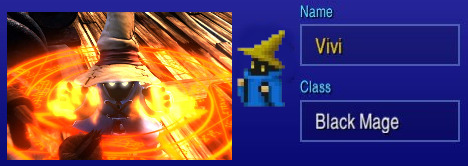
Vivi, the Black Mage/Black Wizard Wow gee whiz I wonder why I named my Black Mage Vivi. In case you didn’t know, this is the Black Mage that appears in Final Fantasy IX and he pretty much just looks like a Black Mage. Unfortunately I forget that the Black Wizard looks like a completely different Final Fantasy character

Ah well. I’ll just pretend Sabin came in to replace Vivi halfway through and he learned black magic or something, I dunno.
In this playthrough, Vivi was pretty much my ‘oh my fucking god I don’t want to sit through this random battle, use Flare or something so we can move on’ character. In boss battles he was my second most valuable damage dealer, but he was also squishy enough that it felt like he would go down before I even knew it. But boy, casting Blizzaga once was great. Usually my strategy with him would be to cast haste on Chuck or Rich Evans and then cause whatever damage I can (In FF1 haste makes it so you hit someone more times on your turn, so it’s a damage buff. It doesn’t make you faster like it would in an ATB game). I like having a magic damage dealer in the party just because you run into those pesky slime-style enemies that take like four damage to sword strikes, but I didn’t run into THAT many of those and when I did Chuck or GP or HP? would usually score a crit and take care of things. I didn’t mention it above but the crit rate had to be upped by like 1000%, I got them all the time.
So basically in my next playthrough it’s KNIGHT KNIGHT KNIGHT and White Wizard. Speaking of White Wizard, I didn’t mention the other two classes: Black Belt/Monk and White Mage. I, uh, didn’t use them but I thought I would mention them. Masters, the evolved form of monk/black belts, are a more useless dps than the Ninja and White Mages/Wizards are healer first characters. There!
Princess Sarah

She is the princess of Cornelia/Corneria. Calling her a major character is a bit of a stretch, but the journey of the Warriors of Light technically starts with her kidnapping at the hands of Garland. Plus, she gets used in a lot of supplementary material later on. She gets a major role in World of Final Fantasy from what I remember. I included this specific screenshot because I have no idea what she’s trying to say here. Is she trying to say she wants to have some alone time with Chuck? Is the screen fixing to fade to black with her going “you’re so norty?”
Bahamut

For funsies I decided to compare Pixel Remaster Bahamut to other forms of Bahamut. On the left is NES Bahamut. Not quite intimidating, I would say Pixel Remaster Bahamut looks like Bahamut Zero in comparison. On the right is a version of Bahamut from the PSP version of Final Fantasy. I haven’t played that specific version but I included it because I just think that style really sucks compared to the more pixelated version.
Bahamut has one role in this game: to give your team a class change. It’s the one thing I would call a sidequest in the original Final Fantasy and it is so important that I almost hesitate to call it a sidequest. Changing your class makes your character exponentially more powerful. For challenge run fanatics, I’m sure using the starter classes is neat and all, but for people like me who cower at such things…you’re going to want to run around with a ninja instead of a thief.
He doesn’t have much of a character outside of this though. He’s just a kindly king of the dragons. I just thought it was neat that the most iconic summon in the franchise got his start in the very first game. A lot of series staples from Final Fantasy don’t originate with the first game, but this bad boy does.
Cid!?

The above screenshot is talking about the creation of the airship. Cute! Of course, this line of dialogue isn’t in the original game because it’s a little too on the nose. The tradition of Cid in numbered games wouldn’t start until 2, but this little throwaway line of dialogue that was added in the GBA remake of Final Fantasy tried to tie it all together. I don’t like this little bit of retroactive continuity but felt it was important to note that it’s in the most easily accessible version of the game. But it’s a lie! Ignore this NPC! Booo!
I didn’t know where to put this but I love the Troll

NES on the left, Pixel Remaster on the right. Look at this guy! You can practically hear him go “AIEEEEEEE YOU’VE RUINED MY LIFE IT’S OVER FOR ME AGGGGGGGGGGH” Plus I love the shadow on his crotch. This is a family game, you can’t just put troll penis everywhere all willy nilly.
The Four Fiends

Some more sprite comparisons for you. I really like the updated versions of these guys, I think they do a good job of capturing the spirit of the original designs. Upper Left: Lich (Earth). Upper Right: Marilith/Kary (Fire). Lower Left: Kraken (Water). Lower Right: Tiamat (Wind)
These guys are your main ‘boss’ enemies, they guard the four crystals. They snuffed the light out of them so to speak. They have no characterization at all, but they are the big bads of the game and even show up for rematches in the final dungeon. In this playthrough, I struggled the most with Marilith. She was unleashing fire attacks that would just obliterate my entire party, save for Chuck. I think he wound up winning the fight with about 40 HP left. I think these enemies are particularly effective in the Pixel Remaster because they represent a spike in difficulty. The game is a total cakewalk until you reach Lich. He has more HP and causes more damage than anything you have faced so far and, to me, represented the first serious threat of death. It’s a little unnerving seeing your number two DPS cause like 30 damage.
The fights you have against them at the end of the game are intense. A lot of end game enemies love using death against you. While you can guard yourself against that, it can still be a little frustrating to be smacked with it if you’re not ready. In the Pixel Remaster, this is lessened by the ability to save before each battle but in the NES version you really need to be on your game to make it out of the final dungeon alive.
Garland/Chaos

The first and final boss of Final Fantasy. It’s like poetry, it rhymes. He was once a loyal knight of Cornelia but became corrupted at some point and kidnapped Princess Sarah. It turns out the four fiends you defeated were Garland’s servants from 2000 years ago and sent him back to the past to heal after your party kicks his ass at the start of the game. When you defeat the four fiends, it opens a portal in the chaos shrine to that period of time so you can finish things. You then fight his true form Chaos. To learn more about Garland and Chaos, make sure to play the hit game “Stranger of Paradise: Final Fantasy Origin.” Are you a bad enough dude to take out Chaos!?
Chaos represents probably the harshest swing of difficulty in the Pixel Remaster. The game doesn’t present much of a challenge until this point. As I said, no game overs. Then you fight Chaos and all of a sudden the game remembers its NES roots. Chaos causes ~300 damage per attack – Vivi had 450-ish HP on my first attempt – and this gets boosted up to around 700 per hit if he casts haste on himself. On top of this, he can randomly cast curaja on himself to completely heal up. It’s frustrating causing thousands of damage only to see that 9,999 in green text. It’s a true endurance fight and definitely worthy of being the final boss of this game.
When I got to him, I believe my party had just hit level 50. This is the original level cap and it took a zillion years to hit it in the NES version, so I assumed I would just stroll up and win like I did with every other battle. Nope! Obliterated. Luckily I took advantage of the quicksave function the remaster added and after I got slaughtered about five times in a row I went back to grind. Finally, I was getting that authentic FF experience I spent a few paragraphs bitching about up there! I decided to give it a go after my characters hit level 57 and…I did better but I was still getting my ass kicked. Eventually though, I prevailed. I used an item to get Saber on Chuck and kept him hasted, I used an item to get blink (helps with evasion though if it did anything who can say) on GP or HP and I just prayed Vivi stayed alive long enough to cast Haste on everyone. I suck and didn’t realize I had temper and that temper could stack so that probably would have helped but hey. I won in the end. And only Vivi died! So I’ll take it.
I was just relieved he didn’t have another form. Hey it’s early, the form changes will come later I assure you.
It started here
With each Final Fantasy, I want to note when certain series traditions start. Sorry if some of these seem really obvious.
Four Fiends, Crystals, Warriors of Light, Jobs, turn based battles, the world map, random encounters and Nobuo Uematsu
This is the game that started it all, so of course it establishes the basics of the franchise. Felt it was important to list Uematsu here because he is the main composer for the franchise. He’s been here since day one!
These all get talked about in some way above, so I won’t dwell on it too much, but these things appear over and over again in the franchise. Jobs, called classes here, get several games in which they are more prevalent so I will save that discussion for a later day. The other elements pop up from time to time too, whether in the mainline series or in spinoffs. Final Fantasy IX, for example, lifts the four fiends and crystals wholesale for its endgame, which makes sense given that FFIX is sort of a ‘series celebration’ game.
Class changes
Hardly a Final Fantasy invention, but still something that I would consider a staple, especially in those job heavy games I mention above. When your character gets a class change, it feels like a significant moment and comes with a giant change in power. They don’t happen in every Final Fantasy title but you always remember when they do happen. Probably the most remembered example of this is Cecil’s transformation into a paladin in Final Fantasy IV.
Airships, boats, etc
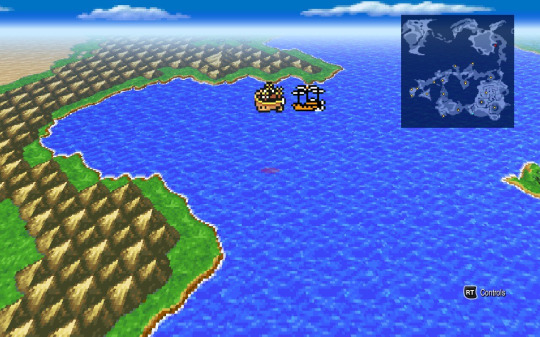
Another little graphic comparison for you. On the left is the Pixel Remaster airship and on the right is the NES airship. I actually prefer the NES airship because it reminds me of one of those wacky flying inventions people would make. But this isn’t a bad take on it.
Final Fantasy is a game about exploring the world and one of the best ways to explore the world quickly is a vehicle! The first one you get in FFI is a ship and later you get an airship. This progression is consistent with the rest of the series because you don’t usually just get an airship, you receive various vehicles with various limitations. Sure everybody loves the Highwind in Final Fantasy VII, but you can’t get that without first experiencing the tiny bronco, the buggy and a chocobo.
Colored magic
Not exactly a Final Fantasy original, but this game establishes black magic as the damage dealing kind of magic and white magic as the healing sort of magic. Black magic has a lot more support options in this game than it typically does, so the distinction isn’t quite as stark as it would become. We do not get to experience the joys of blue magic just yet, but it will come whether you want it to or not.

Some beloved enemies
A couple of series staple enemies start here, though their designs aren’t quite familiar. Evil eye (I always call him Ahriman, even though I know that isn’t the species name), Black flans, Minotaurs, Goblins, Ochu, Elementals, Gigas, Giant Worms and probably many others that I can’t think of right now pop up here. No cactuar or tonberry though. You gotta earn those mascot enemies!
Super bosses…kinda
It’s not actually the hardest boss in the game, that’s chaos, but in the Flying Fortress you have the chance to randomly encounter an enemy called Warmech. This guy is stronger than most bosses and basically every random encounter in the game. It only appears on one floor though and you may not even encounter it unless you’re unlucky – so you either prepare for it and hunt it down like you would a typical super boss or you get unlucky and have to either run or die. It doesn’t have the difficulty of a super boss but I think the odd nature in which it is encountered makes it kind of close.
Ultimate weapons…kinda
The Excalibur is the second most powerful weapon in Final Fantasy I, behind the Masamune which can be found in the final dungeon. It is exclusive to the Warrior and you have to find an item called Adamantite in the Flying Fortress (where the Air crystal is) in order to have it made for you. Character specific ultimate weapons would go on to become a major staple of the franchise, so I thought this game having a class specific ultimate weapon was worth noting. The reason I say “kinda” in the header here is because I really feel like the ultimate weapon should be the strongest one.
In conclusion
So is this game worth playing? Yes. Ideally in the original format but if you don’t have the patience for that sort of thing, I don’t think it’s a bad thing to play the Pixel Remaster version of the game. I do think your experience with the game isn’t as authentic and you’re not experiencing the most ‘true’ version of the original Final Fantasy, but it’s at least closer to the real thing than other remakes. I would say start with the NES version and if you find yourself running into a brick wall early on, switch it up. At least you have an idea for how the original feels.
The original Final Fantasy is an old and hard to approach game and it only gets more so with age. But if you want to appreciate what the franchise would go on to become, if you want to understand just how far things have come, you should try.
Thank you very much for bearing with me and reading this far. Just like with the original Final Fantasy, I’ll be learning just what I want to make of these writeups as I do them. As I said up there somewhere, I have wanted to do a writeup of this series for a long time. At least a decade. So even giving me a couple of minutes of your time is appreciated.
Up Next

Final Fantasy 2, a notorious sequel.
#Final Fantasy#Final Fantasy I#Final Fantasy retrospectives#video games#retro#jrpg#ramblings#video game thoughts#vidya thoughts#ps5#pc#switch#opinion
6 notes
·
View notes
Text
Looking at the self doubt and intrusive voices of Alan Wake 2

Note: I tread very lightly on spoilers in this writeup, however I do discuss an endgame scenario, so if you wish to enter that segment of the game completely fresh I would visit this piece after finishing the game.
Last year, a lot of praise was circulating around over the movie Puss in Boots: The Last Wish. Not only was it apparently a very good movie, but it also contained a realistic depiction of a panic attack. For as much as mental health issues have been brought to the forefront in recent days, it seems like accurate depictions of actual mental health events are quite rare. Especially in children's media
Gaming received a moment like this in 2023 but it is far less talked about. Sure, fans of the game probably discuss it amongst themselves because that's what fans do, but the wider public hasn't grasped onto it yet. Hey, 2023 was an astounding year for games, stuff is going to slip through the cracks.
Alan Wake 2 contains a constantly shifting and complex narrative. The world seems to be changing based on the story the titular character Alan Wake is writing. The player will likely be questioning their memory on certain things as they play. "Did this interaction play out as I remember it? Did I miss a key point in the narrative that would clue me in as to what's going on?" Nothing is quite as it seems and you are constantly guessing about what is going on as you play.

Probably the biggest 'questioning the narrative' moment in the game is related to one of the game's playable characters Saga Anderson and her daughter, Logan. Saga is sent to a town called Bright Falls to investigate a series of supernatural murders. You witness a phone conversation towards the start of the narrative between Saga, her husband and her daughter that's fairly innocuous. It basically just tells you that they're a loving family. But that's the last little bit we hear about this happy family throughout. From that point forward, things change.
Various citizens of the town you're in act like Saga is an old regular of the place. They address her by her first name and speak in very familiar tones. They think she separated from her husband and took her daughter with her to this down. Oh, and also her daughter died via drowning. Kind of a heavy pill to swallow but one you probably shake off the first couple of times you hear it because you witnessed that phone call at the beginning of the game. You HEARD her marriage was happy and you even heard her daughter. Things are fine.
But as the game goes on, more NPCs mention this to you. In fact, basically every plot relevant character including Saga's partner thinks Logan is dead. Eventually you start to doubt yourself. Did you actually experience that phone call at the beginning of the game or is it a false memory? You didn't actually SEE the characters she was speaking to, was it something she hallucinated? Is the twist for this game that the narrative impacting the game world never actually twisted this part of Saga's life?
As the player, it's hard to determine what's real. In a lot of games, the character the player is controlling doesn't actually mirror the emotions of the player. You might be confused but the main character isn't. It all makes perfect sense to them! And for a lot of this game, Saga comes across as someone who absolutely believes her version of events. Logan is alive. Her marriage is fine. Alan's narrative is shifting the world and fixing that will fix everything. As a player I was second guessing everything the game was throwing at me but the character I was controlling was more sure of herself.
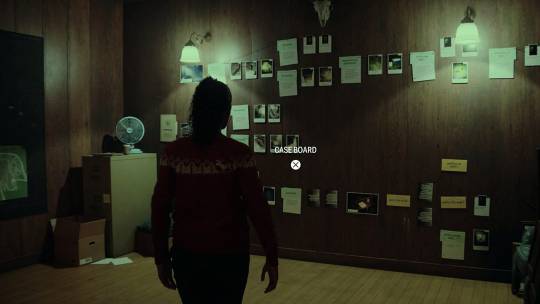
However, we get to peer into Saga's mind a fair amount. The game has a gameplay mode called "The Mind Place." In it, Saga can deduce pieces of evidence related to the various cases you undertake. You can get her perspective on a lot of events in the game this way. A lot can be inferred about Saga's personality through this. You find out she is very sure of herself and competent. But in the end game, things change.
After a wild sequence of events, Saga is locked in the mind place. Usually when you can exit out of there with the press of a button, but no matter what you do, you are stuck. With nowhere to go in the 'real' world you are stuck alone with your thoughts and here are where a lot of your doubts throughout the game come to surface. You grab various pieces of evidence throughout your mind and all of them are just overwhelmingly negative. "You are a bad mom, you are a bad cop, you let your kid die, you are a bad wife." With every new piece of evidence you collect, the player and Saga's doubts become more and more intertwined.
It hits hardest when you're dealing with Logan. Every piece of evidence basically just screams "YOUKILLEDHERYOUKILLEDHERYOUKILELDHER" over and over again. The evidence is accompanied by a picture of your daughter that slowly fades after each message. Is everything the NPCs were telling us about this character true? Is it possible that everyone else in the world is wrong and her life actually does suck?
When I'm having a dark period of time and I think everything is bad, I often search for proof that things aren't as bad as they seem. I think of interactions I've had with people or stuff I've done at my job and go "okay so maybe I'm not as bad as I think" but invariably when I try to cheer myself up like this, a voice in the back of my head calls bullshit on everything I am saying and pops up right when I am on the brink of breaking out of it. "Oh that person was just being nice to you" "Oh, you just achieved that because you knew the right person" "You have done nothing with your life." That sort of stuff.

And wouldn't you know it, Saga does the same thing. She rejects that the death of her daughter is a reality and tries to find evidence to support this theory. All very strong stuff and a lot of it is not new information to the player. And yet, with every bit of evidence you collect that suggests maybe you're not a bad wife and mother, maybe you're not a bad fed, Saga basically screams at you that you're wrong and in denial. That you are looking for an easy escape to the obvious solution. That you are merely coping to evade reality.
Eventually your evidence becomes so strong that you snap out of your funk and are able to leave the mind place and return to 'reality.' Saga still has those lingering doubts, but she also has given herself enough reasons to believe that the doubts are in her head. She is at a point where she is comfortable confronting the nature of her personal life. You know in the back of her head she's not sure what she's gonna find on the other side of her mind place, but she is at least no longer content with sitting in obliviousness.
The handling of intrusive thoughts is done so well. You the player are the one who is going about grabbing the evidence that you're not mentally broken, but the voice in the back of your head is shoving all the bad thoughts up front whether you want them to or not. I cannot overstate how gripping the storytelling is during this 30 minute segment. Many people would call the gameplay in this section 'walking-sim' esque, but I would argue it the most gripping bit of gameplay in the game despite not requiring anything out of the player from a reflex perspective.
There are no fail states. It's just you and the mind of one of the characters you've spent the past several hours with. And it is enthralling.

#Alan Wake 2#opinion#rambling#video games#narratives#alan wake#remedy#saga anderson#ps5#xbox#epic game store#gaming#vidya#mental health#self doubt
20 notes
·
View notes
Text
Super Mario RPG: An effective trojan horse

In 1992, a game called Final Fantasy Mystic Quest released. Despite being a Japanese game developed by Japanese developers, it had an English language target audience. Role Playing Games, specifically of the turn based variety, were all the rage in Japan. Dragon Quest in particular was so popular that kids would skip school to pick it up. You see, back in the stone age, there were no digital games. If you couldn't secure a physical copy, you were out of luck. So what does a young man who wants to fight slimes do? Skip school. According to an interview with Game Informer, police asked Enix to release their games on the weekend to avoid this. So they did.
But this sort of hysteria for role playing games was not seen in America. Yeah, there were definitely people who would camp out and try to snag a copy of Super Mario Brothers 2 or something, but there wasn't a bunch of nerdy kids trying to bum rush the store to see what the hell Cecil and Kain were up to. So Squaresoft wanted to fix this and their solution was Final Fantasy Mystic Quest. It was supposed to be a trojan horse into the genre. Instead of being overly complex and dense, it was simple and easy to approach. You get a small taste...but you still crave more. Yes, JRPGs are crack cocaine.
While RPGs would eventually find a foothold in the states, Final Fantasy Mystic Quest wasn't exactly successful in its mission. Whenever you hear people reminisce fondly about Super Nintendo RPGs, you very rarely hear someone wax poetically about Mystic Quest. In fact, I would argue it is one of the more 'obscure' Final Fantasy games despite its mission to act as an entryway for children. Square's intended trojan horse was a dud, but there's one other game a suspicious number of people think fondly of. It also goes for the same 'simplistic approach to a complicated genre' thing Mystic Quest went for.
That game is Super Mario RPG. I speak of it in a similar 'trojan horse to the genre' way as Mystic Quest because that was quite literally the case for me. I had never heard the letters "RPG" together before. I was an eight year old and all I knew about the game was that it starred Mario and the screenshots in gamepro looked cool as hell. I remember playing this game for the first time vividly. My eyes had just gotten dilated because they were testing my vision and my dad decided to rent me a game to make my suffering less apparent. I saw Super Mario RPG and the choice was obvious. Everything about the world charmed me.

I loved the music and the quirky dialogue. I felt there were a lot of mysteries in the world to see that were just beyond my reach. For instance, I spent hours trying to figure out what Toadstool's "???" was. I tried to figure out where Toad's bazooka was because if he mentioned it, that must mean he has one somewhere and maybe he could join my party! Hell, some kid at school told me about a weird glitch in the beginning of the game where if you pressed a bunch of buttons in some sort of order you would trigger three hidden characters who would join your party. I spent hours trying to figure out how to get Yoshi to leave Yoshi's Island and come with me. Things like hidden treasure boxes and the lazy shell actually existing in game helped propel these wild theories.
Basically, if you experienced the Pokemon phenomenon of the 90s, you know where I'm coming from. It was impossible to be on a school ground and not hear about moving the truck for Mew or learning about Bill's Secret Garden or Pikablu. Mario RPG was that for me on a much smaller scale. I had never seen a game with such a fleshed out story before. In short, I was hooked.
This discovery led me to many other video games I might not have tried otherwise. It led me to renting Earthbound, Chrono Trigger, Final Fantasy IV (2), Final Fantasy VI (3) and basically anything that I thought had turn based combat. Basically this simplistic game featuring Mario fighting a scary blacksmith kicked off my lifelong fascination with a genre. My excursion to a rental store as an eight year old probably led Squaresoft (now Square Enix) to profit thousands of dollars from me alone. And given the reverence surrounding this game, there's just no way I'm alone.
If you go back and play Super Mario RPG as an adult, it's still a really good time. As someone with a great deal of nostalgia for it, it's hard for me to look at it objectively. But when I compare SMRPG to its contemporaries, I really don't think it measures up. The gameplay is simplistic and laughably easy - the game's super boss Culex would probably be seen as a mid tier boss in Final Fantasy IV - there isn't a whole lot of depth to how you build your characters, the item inventory is extremely simple and easy to manage and the game's stages are very easy to navigate. SNES RPGs could feel labyrinthian at times and that's before I get to stuff like Shin Megami Tensei, which released in 1992.

This isn't to say that SMRPG is a bad game. It absolutely isn't. While it is simplistic, I think there are four things that carry it a long way. The things that make it a game that hooked countless children and made them RPG addicts.
First is the undeniable charm of everything. Super Mario RPG is bursting with personality. The story does not have a lot of depth, but the character dialogue is all interesting and quirky. If you compare it to the NPC dialogue of something like Final Fantasy IV, I think it's a lot more interesting. Children's media tends to be brightly colored and loud and I would suggest SMRPG fits in with that. Even the volcano world is full of personality and color. Who could forget the Axim Rangers? I remember thinking it was hilarious that you had to sleep on the boxes at the volcano Inn.
Second is the music. As is typical with most Squaresoft RPGs of the 90s, the soundtrack is excellent. If you pull up a random youtuber's videos, odds are you will hear a Super Mario RPG track at some point. The music is distinct and memorable. Honestly, as far as SNES RPGs are concerned, I think it hangs with Chrono Trigger and Earthbound in the sound department. This is insanely high praise and if this is your first experience with a game like this, you will remember these tunes.
Third is the fact that it is a Mario game. Final Fantasy Mystic Quest's main character is Benjamin. Not exactly a memorable name like Cloud or Cecil. His Japanese name was Zash though, I guess that's kinda cool! This game stars Mario. As a child, you could slap that plumber's face on anything and I would instantly buy it. Recruiting Princess Toadstool (before everyone knew her name was Peach) and Bowser into your party was just the coolest thing. This wasn't the first Mario spin-off, but it was probably the first one that didn't make you shove your head in a history book. People love those characters, so sticking them in a quirky and colorful world is going to make for a beloved game.
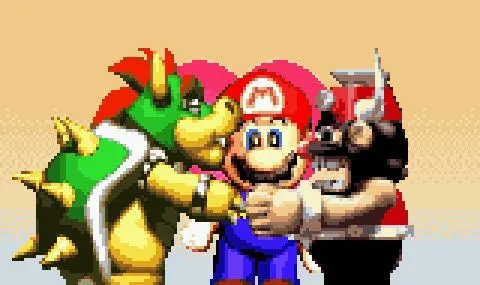
Lastly is the difficulty. It's no secret that RPGs used to be a lot more grindy than they are now. It's something you either love or you hate. SMRPG does not require a grind at all. You certainly *can* if you want to, but you don't have to be anywhere near the max level to finish off the game and even then, I think on my most recent run everybody was fairly close to it anyway and I assure you I did not go out of my way to fight goombas. This is a game that was designed to be beaten. No matter how much a kid runs into a wall, they will probably find a way to come out on top. So you leave this beautiful colorful and quirky game feeling good about yourself because you beat it. There is maybe one non-Culex boss that could be defined as 'that boss' and it's a monster wedding cake. ...Ya see what I mean about a world full of personality?
The things surrounding the actual game take what could have just been a ho-hum average experience and elevates it to the next level. You will see RPG snobs turn their nose up at this game because of its simplicity, but I think SMRPG accomplished exactly what it was trying to do. It created a horde of people invested in RPGs. Even if they didn't stick with other games in the genre like I did, they probably tried at least one or two others.
Whether intentionally done or not, Super Mario RPG achieved what Final Fantasy Mystic Quest set out to do. While I don't think there's any chance the remake will be able to capture that same magic, I would bet that a lot of 30+ year old men and women will be sitting in front of their televisions this weekend feeling that they've gone back in time. Cursing Sakurai for not placing Geno in Smash. Feeling like they need to figure out how to get Luigi to join your party because that one star in star road was clearly written by him and god dammit he is probably stronger than mallow at least right?
It's not the best game. But it is a beautiful one.
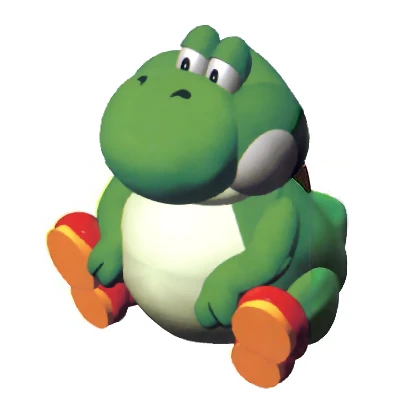
5 notes
·
View notes
Text
Like a Dragon and how video games can tell stories in a different way than other visual mediums

NOTE: This is best read after playing Like a Dragon Gaiden: The Man Who Erased His Name. I do not mark spoilers, so if you want to experience the end to the game yourself, I suggest you go play.
When you sit down with a television show or movie, you give a commitment of time to it. For a movie, let's say two-and-a-half hours. For a series of 10 movies, that's 25 hours of time. For a television show, this expands a fair deal. The running time for a drama that most of you reading knows about, Breaking Bad, clocks in at around 60 hours. For a series like the Simpsons, that has been going on for basically forever, that running time is 200 hours.
This is where video games set themselves apart. For a long time, I considered a 'long' playtime of a game to clock in at around 60 hours. I'm just talking about single player RPGs here, for an MMO this is basically baby stuff. In my playthrough of Persona 5 Royal, I think I spent around 100 hours with that cast of characters. 100 hours with Joker and Makoto, 60 hours with Walter White.
This time, think about a long running video game franchise. Earlier we established for a series of 10 movies, you'd have around 25 hours of run time. Let's expound on this and think about the James Bond movie franchise. 53 and a half hours for all 25 movies. A pretty solid amount of time to understand one character I would say. That's still shorter than your average long video game. But what about a series of long video games?

The Yakuza franchise has been running since December 8, 2005 and encompasses seven (soon to be eight) mainline titles and several spinoff games. The franchise, up until Yakuza: Like a Dragon, focused primarily on the exploits of Kazuma Kiryu. If you focus primarily on the main story of every game that has been released in the West, you're probably looking at well over 200 hours of gametime. Roughly as many hours as one would put into watching every episode of The Simpsons. If you do every substory and try to experience as much of the story of every game as possible? Your playtime is going to eclipse 500 hours and that is probably being conservative. 200 hours for 34 years of watching Simpsons. 500+ for 18 years of Yakuza where you get to live through the exploits of a fictional character.
That's 500 hours of getting to know Kazuma Kiryu. There are people who have spent more time with this virtual former Yakuza than they have with their own real life friends. As one of those people who has sunk 500+ hours into the franchise, I feel like I have gotten to know Kiryu very well. He is a stoic man. He has a kind side and will help basically anybody who is down on their luck, but he doesn't seem overly sentimental about it. He does show a love and fondness for people he considers 'family' (A young girl/woman as of Y6 named Haruka that's essentially his adopted daughter, her son Haruto and a crew of orphans) but I don't think he is outwardly sappy about it. You just know he cares.
Not only have we sunken a lot of time into playing as Kiryu, but we have also got to experience him in various stages of life. This is one of the big benefits video gaming has in terms of storytelling. In Breaking Bad, if you wanted to show a 17 year old Walter White, you would need to hire an actor to play him. In Yakuza, no matter what, Kiryu is going to look like and be the same Kiryu. Through playing those 500 hours we have seen Kiryu in various stages of life. We have seen him take the fall for a murder he didn't commit, we have seen him basically adopt a young girl, we have seen him fall in and out of love, we have seen him become the patriarch of the Dojima clan only to vacate it, we have seen him 'retire' into life as a taxi driver and we have gotten to see him be a lovable ol' grandpa. There is no 'other' Kiryu actor. Kiryu is Kiryu.
The latest game in the Yakuza/Like a Dragon franchise (Like a Dragon Gaiden: The Man Who Erased His Name) enters us into another phase of his life. He is a man who must pretend he is dead in order to protect his loved ones. He has basically no interactions with familiar faces from those 500+ hours of gametime. There are only small little parts in the story for series mainstays like Haruka Sawamura, Goro Majima, Taiga Saejima and Daigo Dojima. We only know how Kiryu feels about these people because we have played previous games where he is the star.

Taking him away from those he loves makes for a very isolating experience. The game takes place in familiar territory, but everything feels so foreign. We know this is the guy we've spent so much time with because the game explicitly tells us that he is Kiryu, but he spends most of the game's runtime being referred to as Joryu. Kiryu is supposed to be a dead man, so we have this new identity. Most of that time as Joryu is spent around characters the player probably won't be familiar with. You're playing as someone familiar yet someone different.
Yet at the end of the game, we experience something that feels so much deeper because of how much time we've spent with Kiryu. As I've said, we know he is a stoic man with a heart, but he isn't usually put into situations where he can't interact with his loved ones. This game saves the first interactions with his 'family' for the very end. A camera spies the orphans that he cares about visiting his fake grave. A pair of those orphans notice the camera and start talking to it. They never bought that their 'Uncle Kaz' was dead and take this as a sign that he's still kicking. They proceed to tell him about their life.
As the player, you know this is the one area Kiryu cares deeply about. He loves those damn kids. So you are aware that what you are watching has weight. Your mind might flashback to Yakuza 3 where you experience a great deal of playtime hanging around these orphans. You might remember Kiryu putting on a wrestling match to cheer one of these kids up, you might remember Kiryu trying to find out who stole some money from one of the kids, heck you might even remember having to make donations back to the orphanage during Kiryu's time as a taxi driver in Yakuza 5.
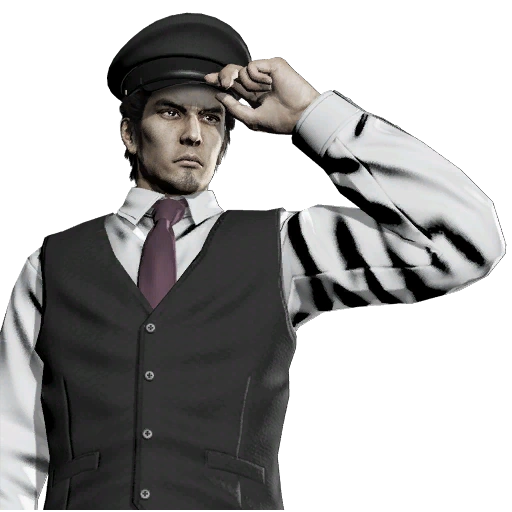
But what really sells that weight is Kiryu's reaction. He openly sobs. And not just silently crying as he watches something, he does what I can best describe as 'ugly crying.' As the orphans talk into the camera about their lives since the death of 'Uncle Kaz,' you hear as his breathing gets more and more shallow. You hear everytime he starts to choke up. You hear him sob. You see tears drop onto the screen. Because you spent so much time living as Kiryu and getting to know him through the franchise, this moment feels exceptionally powerful. You've seen Kiryu cry. You've never seen this.
His voice actor gives such an amazing performance here that I sincerely worry about how the English dub patch will convey this. Kiryu has been voiced by the same man (Takaya Kuroda) since the inception. So when you hear Kiryu break down, you hear the same voice you've heard for years doing it. It's like a dear friend finally can't deal with it anymore. Will his new English voice actor YongYea be able to get across these same complex feelings in a different language? Doubtful.
The conversation ends with the orphans saying they were gonna bring everyone back 'tomorrow' so they could talk with Kiryu too. They even promise to bring a present! Unfortunately, since Kiryu is supposed to be dead and since the orphans weren't actually supposed to spot the camera, there is no second video. The camera got removed. However, the gift still comes. You don't get to physically have it because how can a dead man take something? You get a picture of it instead. It's a drawing made by what is the equivalent to Kiryu's grandchild. Haruka's son. It even has Kiryu in it.
When the player sees this, their mind might flash back to Yakuza 6. The feeling of shock when you discover Haruka now has a child and all the missions spent walking around and comforting this kid. You don't know much about this kid's personality now, but you were there from the beginning. You spent probably 50 hours with that little kid. You had to move the controller up and down to comfort him when he cried. He's Kiryu's 'grandson' but you are aware of him too. You spent time with him.

And Kiryu's tears and reactions to this young boy are every bit as gut wrenching as you might expect. You want nothing more for him to go back to his old life in Kamurocho. You want him and Majima to have one more fight. You want Daigo to show up and be like "Look dude, I need ONE more thing from you." But that time has passed. That Kiryu is gone. And in that moment you feel it. Life has continued without him there and the kids are doing well and he did all he could for them while he was 'alive.' He accomplished something great and as a person who played 500+ hours, you feel a piece of that too.
The feelings you get here are feelings that are exclusive to video games. You simply watch Walter White build his meth empire. You simply watch James Bond race around really shitty CGI icebergs. You got to experience these moments Kiryu went through because for 500+ hours you were there too. You were playing pocket circuit like an idiot, you were training up that number one hostess. You put in the time and you got rewarded for it.
In short, Like a Dragon Gaiden: The Man Who Erased his Name is everything that is right about storytelling in video games. It is an experience that can mean something if you merely watch it on youtube, but if you truly put in those 500+ hours it feels a lot more impactful. I can't wait to see where we go from here.
#Like a Dragon#Like a Dragon Gaiden#The man who erased his name#like a dragon gaiden the man who erased his name#yakuza#video games#opinion#rambling#gaming#ps5#xbox
20 notes
·
View notes
Text
Sea of Stars: The best game you played as a child that released in 2023

When I was in middle school, I have vivid memories of playing Chrono Trigger. I rented it from my local video store, a poor man's family video. It even had a tanning bed, as was the style at the time. I sat in front of my grandmother's mid-size CRT television and was amazed at just about everything I saw. The beautiful pixel art, the various set pieces, the story, the music. Everything. My inner monologue for about a month after experiencing Chrono Trigger for the first time was using "thees" and "thous" a lot like Frog did in that localization. He was the best character so the way he spoke was the best way to speak. Simple as that.
Often times games try to ape Chrono Trigger because my experience with it is hardly a unique one. Most of the time, I feel these games miss the mark or fall short of it. They tease you with the "Chrono Trigger" but it more hits on some highlights that Chrono Trigger had instead of making an actual good game that can stand on its own merits. The example that comes most prominently to mind is "I Am Setsuna," a game I once wrote about on this blog. It's a game that mindlessly tries to take what makes Chrono Trigger a good game and slaps it onto something else. A soulless product developed by a company with a soulless name (Tokyo RPG Factory.)
My brother has been pestering me to play Sea of Stars for months now. Yet the specter of products like "I Am Setsuna" prevented me from making the jump for a long time. Yes, aesthetically, it played the part...but if I were to go back in time and rent this game from the fake Hollywood Video and play this on the mid-size CRT at my grandmother's house, would it capture my imagination? Would it stand on its own?
Yes.

On the surface, Sea of Stars looks like it's trying to be Chrono Trigger. They have the combo attacks, they have the wacky cast of characters from a variety of different backgrounds, the overworld and spritework looks pretty close and the music...well, the music can often feel like it was lifted straight from that very SNES game. But there's more to it than that. Quite literally. Sea of Stars doesn't just try to mimic the style of one beloved RPG, it lifts from several and becomes something of a Jack of all retro turn based trades.
The combat uses timed hits like Super Mario RPG - a system that's extremely easy to wrap your mind around but is extremely adept at keeping the player's attention. You can't just take your mind off of the game once you hit 'attack.' It also has the ability to change your characters in combat, which gives the game something of a Final Fantasy X (it's odd that a 20+ year old game is the 'newest' thing mentioned here) feeling. Sometimes a spot will call for a poison user, sometimes it will call for your warrior cook, sometimes it will call for your moon user. It's simple, but it makes each encounter feel unique and engaging. It also uses something akin to a limit break system, as seen in various Final Fantasy titles. Everybody gets an elaborate ultimate attack. When is the right time to use it? Even more variables tossed into a fairly easy-to-use system.
It's not just in the gameplay either. One of the big mistakes video game companies make when making 'new' retro games is that they cram too much story into the game. Don't get me wrong, stuff like Final Fantasy IV, Lunar Silver Star Story and Chrono Trigger have plenty of story, but go back and play those games and then go play Final Fantasy VII. The amount of dialogue and dedication to storytelling is next level compared to what you get in SNES games. Older RPGs have a smattering of world building and story but that is bolstered by the gameplay. Sea of Stars is similar in this regard. It does not have 'too much' story, it has about as much as you would see in an SNES RPG. It leaves something to the imagination. Not every last detail of the world is explained, you're left with a sense of wonder.
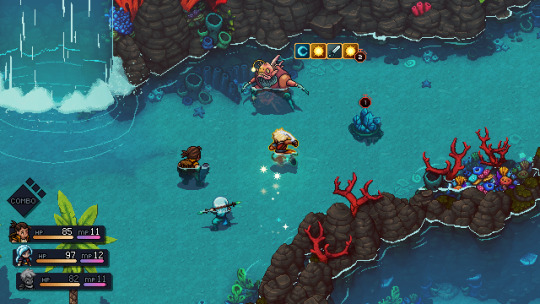
When I first heard the term 'solstice warrior,' I grimaced. It sounded so lame, like something out of a kid's cartoon. And yet, it is tackled with sincerity. They don't go out of their way to tell you every aspect of what goes into making these warriors, they keep things very simple and straight forward. It just feels authentic. By the end of the game I wanted to learn more about this world and these characters, I did not feel like everything had been spelled out in game and there was something left to discover. Even a post-game twist felt like something a kid would tell you at school and you'd just roll your eyes and say 'yeah fucking right Ned, I'm sure collecting all 60 conch shells will do that.'
My discovery with this game is that in order to create a 'love letter' to a genre, you need to focus on more than one game. It needs to just focus on lots of things. I am Setsuna feels like a shallow clone of Chrono Trigger. Sea of Stars feels like a game that saw great elements from a lot of other great games and came to its own conclusions by throwing those things together. I fully believe a middle school aged Derek would have been glued to his Grandma's CRT for a month straight playing this game. It's the highest compliment that I can pay this game. It's not better than Chrono Trigger, Final Fantasy VI or Earthbound. But it still stands on its own and it is fantastic.

111 notes
·
View notes
Text
Mortal Kombat 1's story is embarrassing
NOTE: I will be spoiling the Mortal Kombat 1 story mode, I'm not giving warnings after this. If you want to see it for yourself, please do so before reading this.

Mortal Kombat 9 is one of my favorite stories in a video game. It takes the outline of the first three Mortal Kombat games and turns it into a cinematic story. It's easy to follow, pretty wild and best of all it does not take things safely. MK9 ends with almost every single main cast member dead. When I put down the controller at the end of the story mode, I legitimately thought 'I have no idea how they are going to make a sequel to this.'
It's a story mode that was so impressive that it made me stick around with the franchise despite my misgivings about it. I don't think it plays well and I think the monetization schemes around it are putrid, but I like seeing the stories they have to tell. I felt what Netherrealm Studios did for fighting games was something other studios should copy. I'm a Street Fighter fanboy and I wanted THAT franchise to take from MK. It would take a while but they'd get there eventually.
Unfortunately, those days are long over. Mortal Kombat 1 plays it safe. The end of the most recent game, Mortal Kombat 11, involves Liu Kang restarting history and making it in his own image. He purposefully kneecaps daunting figures from his own history in order to make things slightly better this time around. Shang Tsung is a snake oil salesman, Shao Khan is a loyal guard to empress Sindell, Quan Chi is...I don't know what he was doing but he was not the wacky guy we knew and loved.
Someone doesn't like this though! There is a mysterious figure that is convincing these evil characters to embrace their potential and sew chaos on Liu Kang's world. This could be interesting because, well, how could someone be aware of a history that has been erased? How do they know the significance of these figures? For all they know, Quan Chi is just some bald fella who hangs out at the Hot Topic.

It's revealed that this figure is a version of Shang Tsung from Liu Kang's universe. In the Mortal Kombat 11 Aftermath DLC, Shang Tsung and Liu Kang fight for the ability to control the universe and rewrite history. The player can select either Shang Tsung or Liu Kang to get the ending of their choice. So the person fucking up Liu Kang's new world is from a different timeline. This makes sense, but I do not enjoy stuff like this because I think it shows cowardice. The writers did not want to choose a definitive ending for the first game. Nier this is not.
Before this point, MK1 told a pretty straight forward story. You had a group of characters you got to know with discernable personalities and motivations. Things are different from the world you knew from Mortal Kombat 9, but it's a different universe. That makes sense. When the reveal is made, all pretenses of having a focused story fly out the window. Mortal Kombat changes into a multiverse superhero movie and does not look back.
From the reveal of Titan (the other timeline's) Shang Tsung, everything ceases to matter. None of the characters you have been around for the past few hours are important anymore. It's Fire God Liu Kang and a multiverse of different versions of characters you like. You see, Liu Kang has the idea that there are actually multiple different timelines instead of just the two. So now you get to hang around a bunch of characters from a bunch of different timelines where someone other than Liu Kang or Shang Tsung took control of things. There wasn't this kind of choice in the MK11 DLC. It was one or the other. So instead of making this a "well actually both endings were the real endings" scenario it becomes a "well actually there are infinite possibilities and anything could happen so maybe Sektor or some shit is a time god now who knows?" scenario.
So the game ends with a giant battle royale between warring timelines. Liu Kang with a bunch of people he recruited and Shang Tsung and a bunch of people HE recruited. You get to see a lot of blood and guts here with various alternative versions of familiar characters to see. My favorite is Quantum Chi, what a stupid name. The problem is: these are all meaningless. People die by the dozens, characters you are familiar with, but it doesn't mean anything. They are alternate dimension versions of the characters you know. The ones you spent time with are fine. So why should I care if universe 9172 Mileena Khan gets her head bitten off by universe 8162 Tarkan Kabal? I don't know her.

This all made me think of Across the Spiderverse. That movie took a little time to develop the alternate versions of Spider-Man. I'm not saying they were all fully fleshed out characters, but if Penny Parker were to get killed by Mysterio or something, the viewer would probably care. This game throws all this multiverse stuff at you at the very end. I think there was maybe an hour of gameplay after the big Shang Tsung reveal. There's no time to care about anything. If the plan was a multiverse, why didn't you try to establish it a little sooner? That way I could form an opinion about evil Sonya Blade (cameo only, please buy the DLC). I'm not even picky, just give me a couple lines.
When Mortal Kombat 9 did all of its killing, it took characters you knew for the whole game and just slaughtered them mercilessly. It's not the kind of game where you're going to shed a tear when someone dies, but you do feel *something* when you have to fight all the zombie versions of your characters in that game. Like, you went through a lot of stuff with those guys! In this, all the killing and violence meant nothing. It was just for show. People died but it doesn't matter. They weren't the 'real' versions of those characters. In the next game, we will resume from Liu Kang's universe which is mostly in the same state as we started it in. The only character who dies is Sindel. They actually bring back Kitana's dad from the dead, so our death count goes down by 1. We broke even!
They went the fanservice/multiverse route because it's a popular thing to do. Those kinds of stories are in. But this was just violence for the sake of violence. There was no story to tell, just meaningless bodies to skewer. No real consequences. A decade ago I put down the controller for a game I didn't even think I'd like and said 'What in the world are they going to do for a sequel? I can't wait!' Today I put down my controller and just don't care.
9 notes
·
View notes
Text
My top-10 games of 2018

It’s that time of the year where you are flooded with lists of the best stuff from 2018 and I’m no different. Originally I was going to just make a list of the top 10 games I played in 2018. I even had a giant list I was updating throughout the year. But one day my phone randomly reset and I lost that list. So, business as usual this year. Maybe next year.
Before I start with the numbered list, I’d like to note a couple of games that won’t be appearing for various reasons.
Games I liked a lot but haven’t played enough of to place on a list like this: Into the Breach, Dead Cells
A critically acclaimed game I haven’t played: God of War
I don’t want remakes on my list, but these games were really good: Shadow of the Colossus, Yakuza Kiwami 2 and Spyro Reignited Trilogy
Ports aren’t eligible but I like these a lot too: Donkey Kong Tropical Freeze, Shenmue 1&2, Hyrule Warriors and the PC port of one of the best games ever, Yakuza 0.
Okay, let’s get started.
10-) Red Dead Redemption 2: Actually had to debate between this and Pokemon: Let’s Go Pikachu for this spot. Ultimately I chose this game because the narrative is spectacular. Well that and the fact that Let’s Go is sort of a remake. This game absolutely nails atmospheric storytelling and creates one of the most interesting protagonists in AAA gaming. This game does a lot of things well, but the actual gameplay portion is...pretty mixed. I didn’t have fun with the open world at all and most missions involved long bouts of horseback riding with dialogue or ambient music. But RDR 2 does everything else so well. It also knows when to go all out. Every major mission in the game is memorable for one reason or another, especially with intelligent usage of music. It’s a game I will never play again, but despite some problems with the gameplay I can safely say that I enjoyed my time with it.
9-) Mario Tennis Aces: This game was a lot of fun. I wrote about it earlier in the year and my opinions on it are still the same. Even though the gameplay is fairly simplistic, every match against another human felt unique and different. You have to learn the styles of your opposition and adapt. It’s like a fighting game! The online gameplay was also pretty solid. I felt pretty damn good whenever I would win a tournament. Really, Smash Bros. Ultimate would have done well to borrow this mechanic in some way. The only real problem with the game is that there is just a major lack of content. The heavily advertised story mode is barely worth playing and the cups, well, you might as well be playing against an unmanned player 2. I haven’t touched the game in a while, so this might have been fixed via update. As I said a few months ago, this game could have been a masterpiece with a bit of extra fine tuning.
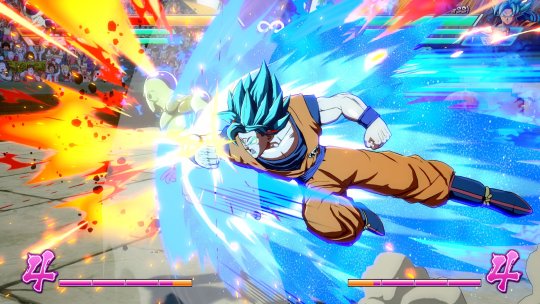
8-) Dragon Ball Fighter Z: This game feels like it was made specifically for me. I have a lot of love for the Marvel vs. Capcom games and even more love for the Dragon Ball franchise. The game is easy to approach for newcomers to this type of game by keeping the inputs simple and having very easy to pull of auto-combos. You won’t do too well online if you stick to the auto combos, but it’s a good way to start and learn how to play. I think a lot of people could start with Fighter Z and transition into more complicated fighting games, which is exactly what you want with a game like this that will attract many people who might not otherwise play a traditional fighter. Oh, and sometimes it looks like you’re playing an episode of the anime which is insane. The story mode is pretty tedious at times, which is a let down, but Fighter Z is an absolute blast to play and is easily the best playing Dragon Ball game yet. Hopefully season 2 of the DLC goes less heavy on all the Gokus.
7-) Mega Man 11: The blue bomber returns! It’s been a long wait, but after playing through both collections last year and then the X-collection earlier this year, I was ready for Mega Man to get back into the spotlight. It’s a little hard to get into at first because the level design seems pretty tied into the main new mechanic, the gear system. Basically the player can slow things down to a crawl or boost Mega Man’s power. If you just play this game like you would any other Mega Man game, you’re probably going to throw your console out the window during Tiki Man’s stage. Once you figure this out, the system adds a unique flavor to the Mega Man experience and feels like an actual new Mega Man. I love MM9 and 10, but those did not feel like new games. The only thing that I didn’t like about this game was the music. Which, uh, is weird for a Mega Man game. Here’s hoping they get it right in the inevitable Mega Man X9.
6-) Marvel’s Spider-Man: I don’t particularly like super hero movies and I haven’t enjoyed a Spider-Man game thoroughly since the first PS1 Spider-Man, so you wouldn’t normally think this game would appeal to me. But it absolutely does. The gameplay is outstanding and combines an improved version of the swinging scene in Spider-Man 2 with a combat system that is fairly similar to the Batman Arkham games. I recommend playing the game on hard because, while it’s hard to get used to, it makes every encounter feel unique. You constantly have to adapt to what the enemy is doing. You can’t just mash on the attack button and then press the dodge button when the dodge prompt comes up.
The story is also interesting throughout. It has my favorite interpretation of Peter Parker I’ve seen in a while and has a pretty enjoyable cast of characters. Really Mary Jane is the only character I didn’t like and even with her, there are moments that hit home - specifically the text exchanges between MJ and Peter. The game is littered with references to past Spidey adventures and just feels like a giant love letter to fans of the hero. Can’t recommend it enough.
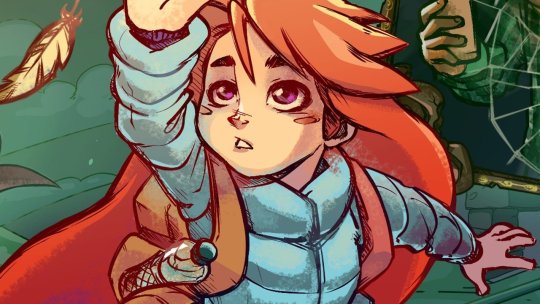
5-) Celeste: I didn’t know what to expect with this game. Sometimes I feel very leery of when a bunch of people prop up an indy game too much. Gone Home a couple of years ago told a pretty mediocre story that was held up as some form of high art. Just didn’t get it. So I went into Celeste wanting to not like it and came out fairly surprised. The gameplay feels like a better version of Super Meat Boy and the narrative tells a pretty compelling tale about depression and how to come to terms with yourself. I even don’t mind the pixel art. I am getting sick of indy games going for the retro aesthetic, but when combined with the great soundtrack it’s hard not to love what it’s presenting.
The game is simple enough to complete on its own. I would argue that anybody could do it as long as they keep at it. But for those platforming veterans, the game also offers a heavy challenge. The B-side and C-side levels will test your skills and remind you of some of the most challenging bits of hard platforming games like Super Meat Boy and I Wanna Be The Guy. Basically, come for the compelling narrative. Stay for the wickedly difficult and addicting gameplay.
4-) Yakuza 6: I believe I enjoyed this game far more than most folks. It told the end of Kazuma Kiryu’s story. It had some problems along the way but my god did I enjoy the ride. The cast of characters surrounding Kiryu in Hiroshima are all great and one of the main characters is Beat Takeshi. It also has a ton of things to do and see. I love the clan wars sidequest featuring New Japan wrestlers, I love the baseball manager quest, I LOVED becoming a regular at a bar and getting to know everyone in it like I was playing some sort of weird Cheers game, I even loved the adult cam chats that came with wacky dialogue. This game is full of charm.
I haven’t mentioned the gameplay yet you might have noticed. That’s because, well, it’s a new direction for the franchise. It focuses on allowing more people to fight Kiryu at once and as a result feels less refined than recent entries Yakuza 0 and Yakuza 5. I am excited to see where they take it in Yakuza 7, but I would be fibbing if I suggested that I felt 6 plays as well as previous entries. Still, the entire Yakuza package is compelling and I never felt like I was scrambling for things to do or see. I don’t 100% games out of obligation. I’m not one of those people that feels the need to 100% every game I play. I 100%ed Yakuza 6 though. And I loved every minute of it, combat and all.

3-) Valkyria Chronicles 4: As none of you might know, I used to review games for a website called 411mania. One of the games I reviewed for them was the original Valkyria Chronicles. Nobody else wanted to do it because it looked like a generic jRPG and I was really the only person on the site who liked jRPGs so the game fell to me. And I absolutely loved it. The story was captivating, the graphics were stylish and and the gameplay felt like a breath of fresh air. It was the combination of a tactical RPG and a (very, very simplified) shooter. To this day it remains one of my favorite games ever. Conversely, Valkyria Chronicles 2 on the PSP is one of my least favorite games ever and 3 never came to the states - though it does have a fan translation. The franchise has felt dead in the west for ages. The musou-like Azure Revolution sure as fuck didn’t get me going.
4 came out this year and it felt like I went back in time. Everything I loved about 1 was back. It’s even expanded upon. The grenadier is a great new troop that feels overpowered at first, but really forces the player to rethink how to approach certain situations. The story isn’t as good as the story in 1, but I found it simple and enjoyable. I genuinely liked the main cast and wanted to see them do well. That’s more than I can say for a lot of games. I know I mentioned earlier in my blurb about Mega Man that what I liked about it was that it actually felt like a new game. The difference here is that I have 10 other Mega Man games that play like Mega Man games. With this franchise, I have 1 (or maybe 2, I hate how maps work on the PSP but I have not played enough of 3 to judge). Sometimes a franchise revival needs to go “like the one you like but more” route. I loved this game and I hope as it gets cheaper more people try it.
2-) Dragon Quest XI: Hey you might notice this about my gaming preferences, but I really enjoy Japanese RPGs! And this sure as hell was one of those! DQ XI felt like a game from another dimension in a lot of ways. It’s a traditional playing Japanese RPG with a big AAA budget. It looks breathtaking. Big budget JRPGs feel like something out of the PS2 era, which is great because I sure love PS2 era RPGs. It’s lengthy, it has a crazy amount of postgame content and has a lot of side stuff in case you get tired of fighting down the main path. It’s a great throwback.
This game also has the most balanced party in recent RPG memory. Usually games like these have one or two party members that you just don’t enjoy. For instance, Final Fantasy X is one of my favorite games ever. But I just don’t like Kimahri. I don’t like using him and I don’t think his character is interesting. DQ XI has nobody like that. I found everybody likable. Sylvando and Jade in particular stand out and are among my favorite characters in gaming. Really, I enjoy everything about this game. Even the music! I know a lot of people complain about the simplified score in the western version, but I honestly found it to work out pretty well for the game. Obviously the Japanese version is superior, but I still enjoy it. If you’re a fan of RPGs and you haven’t played DQ XI, you’re missing out.

1-) Super Smash Brothers Ultimate: This was my most anticipated game of 2018 from the moment it was announced and the final product delivered everything that I had hoped it would. You have a large cast of characters, a crazy number of stages and a bunch of single player content to consume in between bouts of online or local multiplayer. The single player is what ranks this game so high for me. The classic mode - think arcade mode in standard fighters - is easily the best it has ever been. Each character has their own route with their own gimmick, which gives the player incentive to play each and every one. With a roster of over 70 fighters, that’s impressive. The adventure mode can start off slow, but once you get into the groove of it I really think it stands out as something special. It’s an expanded version of event battles from past games. You face off against a fighter (or fighters) embodying the personality of a character that isn’t in the game. They range from obscure stuff you haven’t heard of to a fight with Geno’s spirit that has you do battle with the cast of Super Mario RPG (with substitutes for Geno and Mallow). It feels very creative. It can be grindy for some, but I really enjoyed my time with it.
I think the online could be more fleshed out. I don’t experience as many laggy matches as most people, but even still the options online are fairly bare bones. You don’t even have leaderboards. I want to compare how good I am with how good my friends are! I think Nintendo plans to keep this game alive for the duration of the Switch’s lifespan, so I believe there will be plenty of time to get the online situation perfect. That doesn’t really excuse Nintendo from still not getting online even close to right in 2018, but I find Ultimate to be such a complete package that I can look past these shortcomings. Ultimately, it is my favorite entry in one of my favorite franchises. So it’s pretty easily my game of the year.
#Game of the year#game of 2018#games of the year#Red Dead Redemption 2#Dragon Ball FighterZ#Mario Tennis Aces#Mega Man 11#Spider-Man#Celeste#Yakuza 6#valkyria chronicles 4#Dragon Quest XI#Super Smash Brothers Ultimate#opinion
11 notes
·
View notes